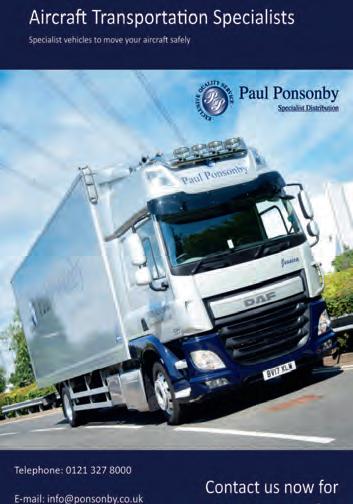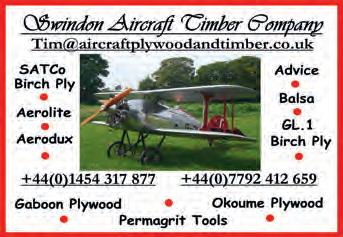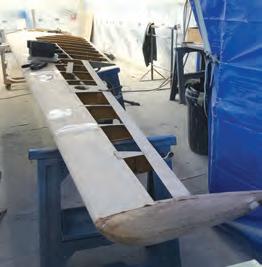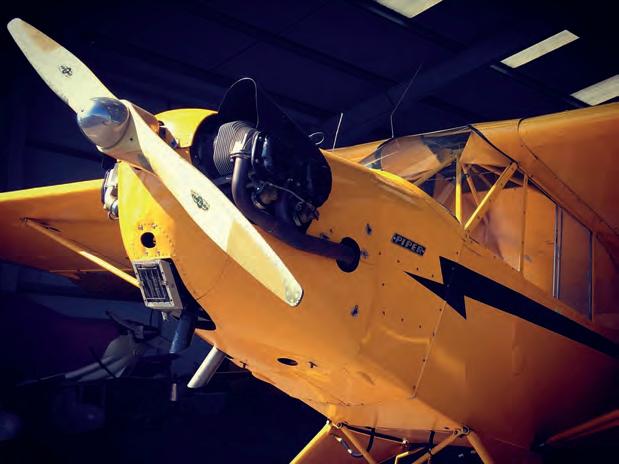
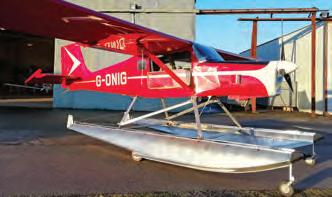
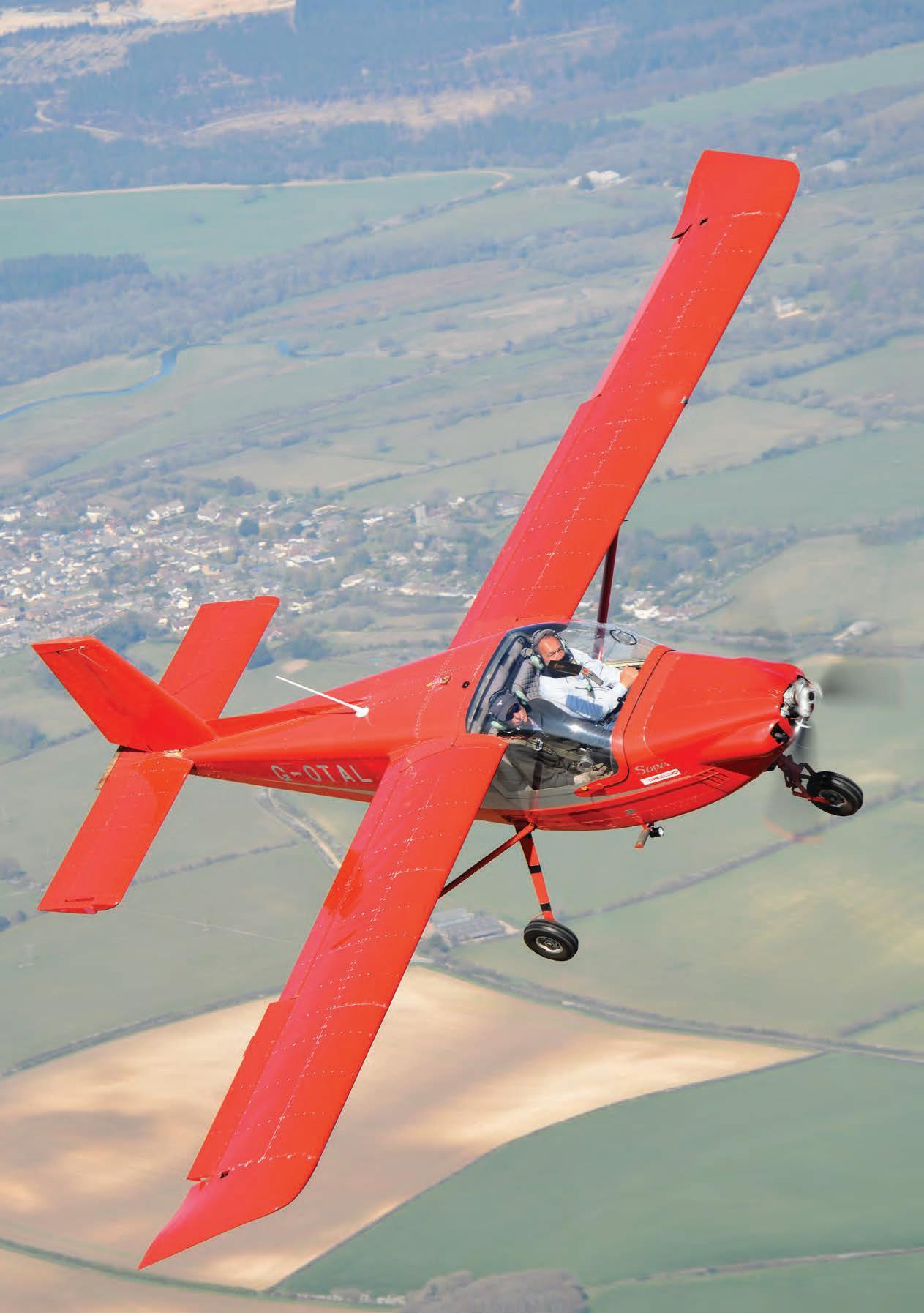

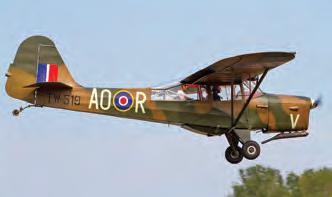

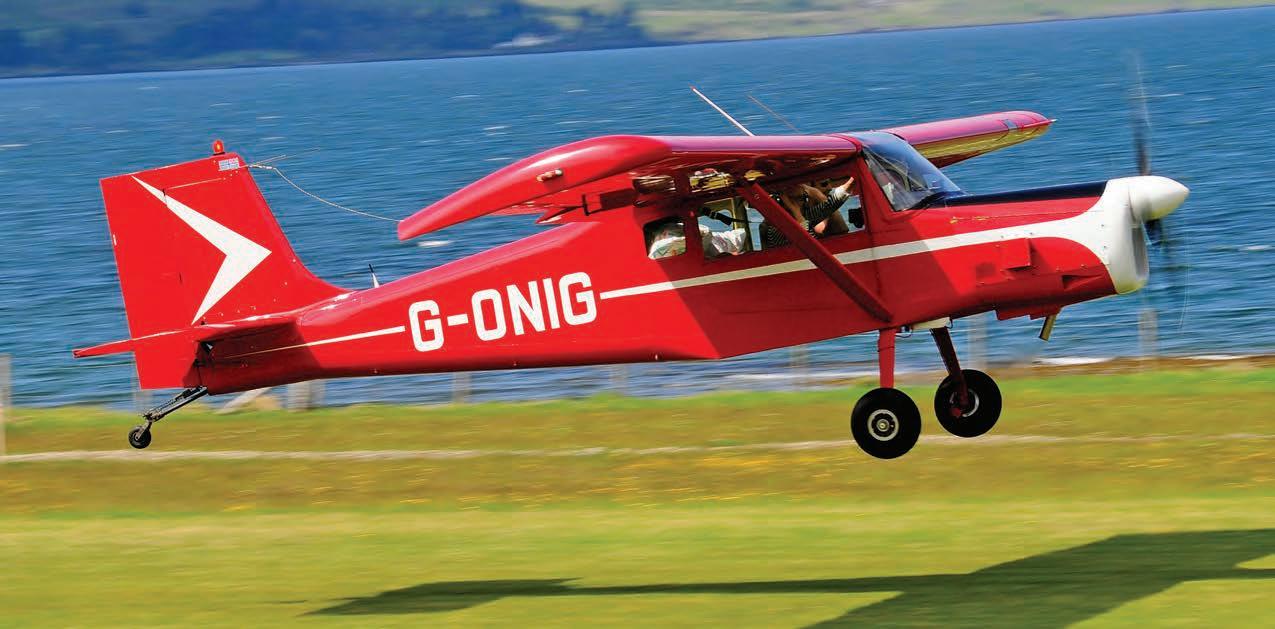








Chairman TIM HARDY
CEO STEPHEN SLATER
Chief Engineer
FRANCIS DONALDSON
B.Tech c eng FRAeS
Chief Inspector
KEN CRAIGIE
President ROGER HOPKINSON
MBE
Vice Presidents
BRIAN DAVIES & JOHN BRADY
Engineering email engineering@laa.uk.com
COMMERCIAL
Email office@laa.uk.com
Office Manager Penny Sharpe
Head Office Turweston Aerodrome, Nr Brackley, Northants NN13 5YD
Telephone for engineering and commercial
01280 846786
LIGHT AVIATION MAGAZINE
Editor BRIAN HOPE
60 Queenborough Road, Sheerness, Kent ME12 3BZ
Telephone 01795 662508
Email bfjjodel@talktalk.net

Welcome to the June issue which, if the magic works, will have arrived with our 75th Anniversary book. It has certainly been something of a labour of love for Steve and me, and a number of contributing authors and photographers, to put together. As far as I am aware, it is the Association’s most comprehensive attempt to date at presenting a look back at our past. I hope you find it interesting.
This month’s cover feature takes a look at an aircraft that is, coincidentally, mentioned briefly in the book, The ARV1 Super2. Many of you no doubt are, like me, old enough to recall the optimism in the aviation community when it was launched in the mid-1980s. As a motorcyclist I had experienced two-stroke engines, I used an old rigid frame D1 125cc BSA Bantam for the 40-mile round trip to work when I was an engineering apprentice – thrash, seize, clutch in, coast for a bit, out with the clutch and carry on. However, by the time of the ARV, I had had an RD250 Yamaha twin, and you could wring the daylights out of it (back then I was young, dumb and... ) and it never so much gave a hint at wanting to nip up, so I was half-way convinced two-strokes in aeroplanes (as opposed to microlights) could work. Such a shame it didn’t, ironically more the fault of the gearbox rather than the engine. The example tested is particularly interesting as it was a factory prototype fitted with an early 80hp 912.
With summer and restrictions favouring some aerial activity we have a couple of interesting flying tales. Harry Leefe recalls
a 2002 flight from Dubrovnik, in Croatia, to Mostar in Bosnia & Herzegovina. It was the first private flight between the two countries since the tragedy of the Balkan conflicts had started 10 years previously.
Closer to home, Martin Ferid visits Haverfordwest in Wales, an airport that has seen much development but has remained a welcoming destination to light aviation.
As Martin suggests, the area offers some interesting options to spend a few days there, rather than simply use it as a staging post before heading across to the Emerald Isle.
For the more technically minded, Ian Fraser discusses a constituent part of what most aircraft builders and renovators often say is something of a black art – aircraft electrics. That constituent is the battery, something that gets quite a hard life in an aeroplane. Ian explains in reasonable layman’s terms, how to check the condition of, and maintain your battery, and offers some helpful advice of what you should consider if you are thinking of going over to lithium rather than lead-acid.
Enjoy the double read this month but most importantly, get out and about and have some fun.
Be safe, Brian

By Brian Hope
By Eryl Smith
As the Association celebrates its 75th Anniversary it is interesting to read in the anniversary book that accompanies this month’s magazine, that you can trace the origins of the current Rally back to small gatherings that commenced in 1948. Initially they were intended to be annual events which moved around the country and relied upon the host venue and local volunteers to stage the event. Over time they have gathered momentum, found semipermanent locations and become the centre piece of the LAA’s events calendar. “Great oaks from little acorns grow” as they say!
But Rallies don’t just happen and what makes for a successful Rally? As we emerge from COVID and look forward to being able to gather again at Sywell in September, planning for this year’s Rally is well in hand. Our well-established collaborative relationship with Sywell sees them providing the base infrastructure, managing the airside arrangements and securing the all important approvals with CAA. It’s a partnership that also ensures the financial stability of the event.
No Rally would be possible without the many volunteers who assist the Working Group to plan and deliver the event. Whether that’s the set-up team who ensure that the site is ready to receive exhibitors and visitors alike; run the camp site and car park throughout the weekend; man the Flea Market; welcome members to the Strut’s stand where copious amounts of tea, coffee, cake and biscuits are consumed; make exhibits available for the homebuilders marquee and demonstrate essential building and maintenance skills and many more besides. This year more than ever we will be reliant on volunteer support to ensure the success of the event so if you or your Strut can spare some time across the weekend, your help will be welcome.
Without those companies who supply the marquees, catering and service the site with loos and showers it would

not be possible to stage the event. Thankfully they have survived the dramatic impact that COVID has had on the outdoor events industry and will be supporting us again this year. COVID has been tough too for our many loyal exhibitors for whom the Rally is a major opportunity to present their wares, and more than ever a source of much needed income for them. For members it’s an opportunity to source those regular or hard to find items, see what’s new or simply seek information on products as they contemplate what their next project or item of equipment should be.
Above all else the Rally is a time to celebrate our passion for sport and recreational flying, the privileges we enjoy and the friendships we make over the years. After the disappointment of the cancellation of last year’s event I know that many members are looking forward to getting back to Sywell for the Rally. This year’s event will have even greater significance given the loss of so many flying events over the last eighteen months, as well the opportunity to celebrate the Association’s 75th Anniversary.
The Rally, and for that matter the Meet the LAA events that are held around the country, provide an excellent opportunity to introduce new members to aviation and the benefits of safe, affordable flying that owning and operating an aircraft under the auspices of LAA enables. Why not take the opportunity to bring a friend with you to one of these events and open their eyes to our world?
Whilst there continues to be much work to be done to plan and prepare for this year’s Rally I am confident that together with our volunteers and the support of our exhibitors, we will once again be able to host a safe and successful event showcasing all that is best in the world of sport and recreational flying. Whether it will be your first time or you are once again returning, I look forward to welcoming you to our Rally at Sywell in September.
06 NEWS
LAA launches new G-INFO C/O LAA member facility, Safesky free traffic app.
8 LETTERS
Remembering Rex Coates, single-seat fun.
10 PROJECT NEWS
Blue Two, Murphy Elite, Zenair CH-750, Cleared to Fly and New Projects.
16 LAA ENGLAND TOUR
Neil Wilson gives the latest details for this 75th Anniversary celebration.
18 BARTON BIRTHDAY
Ernie Horsfall’s Barton birthday fly-in.
20 FLYING ADVENTURE
Martin Ferid visits Haverfordwest to enjoy the pleasures of Pembrokeshire in Wales.
24 COACHING CORNER
David Cockburn offers tips on planning not to infringe.
28 FLIGHT TEST

The delightful ARV1 Super2, a bold British venture that didn’t quite make it…
38 STRUTS4U
Annes Hughes profiles Strut activites.
40 BALKAN ADVENTURE
A post Balkan conflicts flight from Dubrovnik to Mostar by Jodel.
44 FREE LANDINGS
Check out our four free landings for July.
46 OLD WARDEN
Save the date for the Flying For Fun drive-in evening airshow.
48 BATTERIES
Ian Fraser discusses battery maintenance and weight-saving advantage of using lithium technology.
54 MEET THE MEMBERS
Tim Taylor, fast jet, commercial and biz-jet pilot enjoys his Auster.
60 WHERE TO GO
Put these dates in your 2021 diary…
62 CEO THOUGHTS
Steve Slater - the challenges of yesteryear remain with us



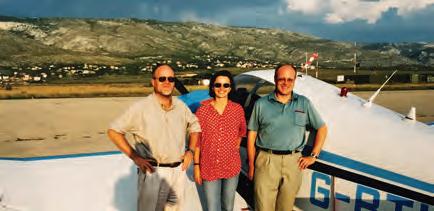
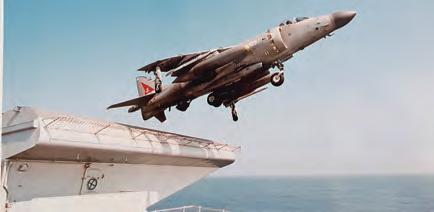
After receiving an increasing number of requests from LAA members, the Association can now provide a PO Box contact address and mail forwarding service to LAA members who do not wish to have their contact address displayed on the CAA aircraft register and G-INFO website.
The ‘G-INFO c/o LAA’ PO Box address facility is for LAA members’ aircraft that are administered by the LAA. The Association will forward mail unopened to the owners’ contact address, as recorded on the LAA Engineering database. Applicants must be
SafeSky is a free, pan-European smartphone app that broadcasts your own aircraft’s position anonymously while receiving the position of other aircraft, using in-flight mobile internet.

It is the creation of a Belgian startup founded by six pilots and has the backing of EASA. It has been in operation in Belgium and France since the end of March but has now been rolled out for the rest of Europe. The company says “SafeSky’s mission is to make the sky the safest place on earth. SafeSky is simple and user-friendly: it relies on the in-flight mobile internet network. Intensive testing on all types of aircraft has shown a very high coverage efficiency (average above 90%) in all kinds of environments, lowlands and mountains, as well as an extremely low data consumption.”
SafeSky aggregates ADS-B, FLARM and OGN traffic and added to the native positions of SafeSky users is said to provide the most complete traffic information system on the market today. SafeSky can be downloaded for free from the App Store or on Google Play. https://www.safesky.app/en
current members of the LAA.
The fee for the service will be £15.00 per aircraft owned by a Single Owner/Single Trustee covering up to three items of letter class post forwarded in that year. The fee is £25 per year for aircraft owned by Multiple Owners or Multiple Trustees and covers up to five items of letter class post forwarded in that year.
“We initially had requests for this service from members who were concerned about their address leading to security and theft risk issues if the address gave away the location of the aircraft” says LAA CEO
Steve Slater. “The enquiries have recently increased further as a result of malicious letters being sent to owners after their aircraft registrations were observed on online radar tracking websites.”
The LAA’s service will ensure public anonymity of the owner’s address via the G-INFO website. However, the owner’s individual name or a named trustee of a group or syndicate is still a CAA requirement for registration purposes. For more information and to download the form, see tinyurl.com/laaaircraftaddress or contact office@laa.uk.com.
The LAA Shop has introduced a range of 1:32 scale plastic display kits of popular homebuilt designs including Europa Monowheel, Europa Tri-gear, Jodel D.11 series, Eurostar SL, Van’s RV-4, Van’s RV-6, Van’s RV-8, Piper J3 Cub, Eurofox 912 and A-22 Foxbat. Other models may be available on request.
These display model kits are manufactured in the UK and are exclusive to the LAA; they come unpainted, unassembled and will require basic finishing (sanding, gluing and painting) to fully customise the model to suit your desired finish and scheme – a perfect mini project for a rainy afternoon.
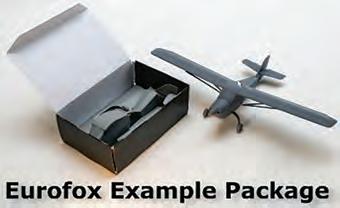
Tools Required are a modelling knife, wet & dry sandpaper, CA Glue, car filler (only a small amount required in some joints), and acrylic based primer and topcoat spray paint.
Lead times can vary but expect delivery within 14 business days. Price £35.00 including P&P
Temporary Danger Area EGD097, will be operating within a five-mile radius of Goodwood Aerodrome on Mondays (AM+PM), Tuesdays (AM only) and Wednesdays (AM only) most weeks between 1 June and 22 September for Beyond Visual Line of Sight (BVLoS) UAV operations at the airfield. AM sessions are 0600 - 0900 and PM sessions are 1800 – 2100 local. Additional days may be added. Activation will be subject to NOTAM with a minimum 24 hours’
notice, and when active, a FISO will be present to safely facilitate arrivals/ departures outside of published hours for Goodwood based operators, short-notice requests for access by airborne emergency services and/or aircraft in distress requiring TDA access.
See AIC Y 011/2021 tinyurl.com/ goodwoodaic112021
Pilots should check NOTAM very carefully for TDA’s as drone activity is becomes more widespread and demanding ever more airspace.

Congratulations to SkyDemon, who have been awarded a second Queen’s Award for Enterprise for International Trade.
The Somerset based company was launched in 2009 by Tim Dawson, who had just obtained his PPL and recognised there was a gap in the market for a pilot led tablet based moving map. The company has continued to enhance their offering ever since, reacting to feedback from users.
SkyDemon has increased its overseas sales by 58% over the past three years and at the company’s offices in Frome, was presented with the award, the most prestigious business awards in the country, by the Queen’s Lord-Lieutenant for Somerset, Annie Law.
Above: The SkyDemon team (Hannah Hart, Louise Southern, Rob Hart and Tim Dawson) with the Queen’s Lord-Lieutenant for Somerset Annie Law and deputy Richard Case.

Chris Heintz, founder of successful kit aircraft manufacturer Zenair, passed away at his home in France on 30 April aged 82. Heintz began his career with Aerospatiale on Concorde but saw his future in light aircraft, so moved to Avions Robin, where he designed the successful all metal HR 100 and HR 200. He also designed his own metal two-seater, the Zenith CH 200.
He moved to Canada in 1973 and flew his CH 200 to Oshkosh that year, establishing Zenair Limited in 1974. The CH200 lead to the single seat CH 100 and the three seat CH 300. Then came the Zipper ultralight, the CH 701 STOL and the CH 601 Zodiac and a move to a purpose-built factory at Huronia Municipal Airport in Midland, Ontario. For some years the company has been run by son Sebastian.
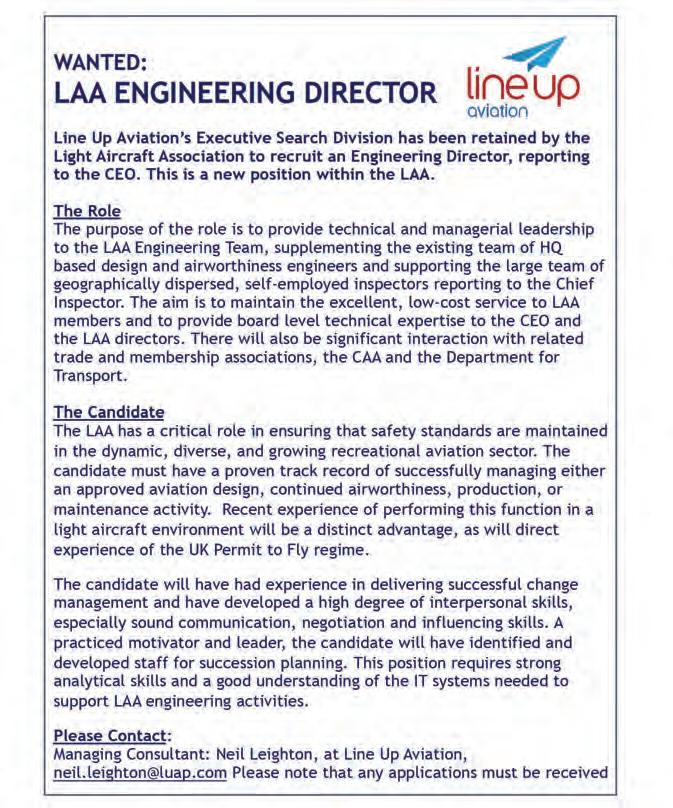
The Vintage Aerobatic World Championship will be held at Breighton in 2022, the first time the event has been staged in the UK. The Championship was instigated in 2016 at Stauning in Denmark for vintage aerobatic aircraft, to once again witness the magnificence of period Zlins, Bückers, Stampes and the like, engaging in competition, their owners and pilots enjoying the revelry and camaraderie of old times.
There are now three categories of aircraft for the competition, the Vintage category for aircraft at least 65 years old. Classic aircraft at least 45 years old, and Replicas of, or re-engined or modified vintage and classic aeroplanes.
On hearing the news that Beighton has been selected to host VWAC 22, Charles Sunter, Chairman of The Real Aeroplane Company, which operates Breighton, commented “Here at Breighton airfield we are delighted to be named as host of the 2022 Vintage Aerobatic World Championship. Home to The Real Aeroplane Company and The Real Aeroplane Club, Breighton is
the leading airfield for vintage aviation in the mid/north of England. We take great pride in enabling fun, grass roots flying. We look forward to hosting the event and to extending a very warm Yorkshire welcome to the VAWC team, the contestants and their ground crew/ supporters”.
This year, covid willing, the Championship takes place at Odense EKOD in Denmark on 19-22 August. www.vintageaerobatic.com

We are always pleased to receive your letters and feedback. Please email the editor at bfjjodel@talktalk.net
Dear Brian, I wish to add my tribute to Rex Coates (pictured). Rex’s expertise covered the whole speed envelope of aviation, rebuilding everything from a Piper Cub to a Mach 2 Supersonic Airliner. His first love was his family, followed by his interest in Miles Aircraft.
Rex owned Miles Monarch G-AFLW, which I had photographed at a White Waltham air display in 1985, without realising it had possibly just made its final flight after a heavy landing. He also owned the Messenger and King’s Cup winner G-AKBO (restored by the late David Fenton), and a Miles M.18 on display at the East Fortune Museum. Coming back from France, his Monarch suffered a bird strike, with a seagull embedded in the leading edge of the plywood leading edge.
Rex confided in me that he never wanted an office job, he wanted to be with the aircraft and work with his hands, and this is why he worked in the aircraft maintenance industry.
Therefore, due to his long service to society and aviation, Rex was part of the country’s backbone and team of unsung heroes that made this country great.
I was first acquainted with Rex, on acquiring Miles M38 Messenger G-AJOE in 2001, and we regularly met up at the Great Vintage Flying Weekend. As a newcomer to Miles aircraft, I
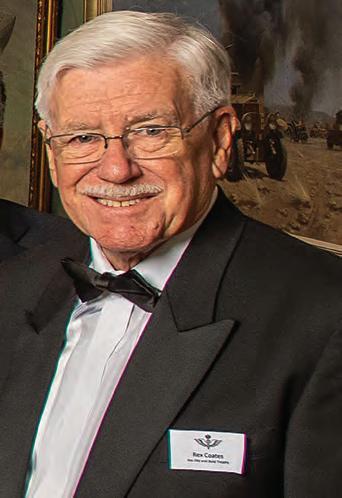
soon learned there are very few people who have any experience today of Miles aircraft, or the 155bhp Blackburn Cirrus.
Rex was a revelation, a very friendly and approachable enthusiast who would always help anyone. Once, in May 2005, flying from Hamburg to the Great Vintage Flying Weekend in stormy weather, the engine seized over
Goes, in North Holland. In the ensuing downwind landing, I hit an unseen dyke channel and the wings and undercarriage were wiped off. Sadly, the aircraft was a total write-off, but I bought the aircraft from the insurers for €3,000. The wreck ended up at Classic Aero Services in France with Patrick Siegwald, and a CAA Engineer oversaw all the work.
Over a period of several years, I worked with both to get the aeroplane rebuilt but without Rex, a rebuild would not have been an option. The wing spars were spliced at 1:30 ratio, and the aircraft finally ready. I then flew the aeroplane to PPS at Booker where Rex subsequently certified the aircraft. The picture (below) shows G-AJOE after its first post-rebuild flight from White Waltham to Henstridge.
Rex visited me several times in Hamburg and would regularly maintain and sign-off G-AJOE. With the passing of Rex, the world and the LAA now loses an expert engineer and specialist for Miles aircraft.
Rex lived a full and interesting life and maintained an interest in Miles right up to the end. My only regret is that due to pressures of life, and Covid-19 restrictions, the flight with him in my Witney Straight never took place.
The only consolation for me, is that he was so deservedly awarded the RAeC ‘Old and Bold’ trophy in 2019 at the RAF Club, but he will be sorely missed in Miles aircraft circles – and

of course by his family and friends. Let’s all wish that Rex’s last flight be his most beautiful. Peter Bishop.
Help please: 1
Dear Brian. I was fascinated by Ian Graham’s letter in the May edition about his aunt’s encounter with a DH.6 on a beach in the 1920s, while it was giving joy rides.
His speculation about the remarkable impression that it must have made on his aunt, and about how many people must have been inspired to become aviators as a result of ‘such cheap and accessible flights’ really chimes with my doctoral research into the democratisation of flight.
I am looking into what made flying more than just a commercial or military activity, one carried out by ordinary people. Ian is right, I think, that joy rides will have been pivotal in making people ‘air-minded’ when flying was still very young; but presumably most of them will not subsequently have taken up flying.
Futurologists, pundits and enthusiasts back in the mists of time, speculated that one day there would be a flying machine in every garage. The myth started even before the car was commonplace, when almost nobody had a garage. It is woven through popular culture and has an enduring potency, even if in reality it seems absurd, improbable and frankly undesirable, now.
I am fascinated by the myth and interested in discovering if all our rational assumptions about why private aviation did not become universal are true, historically. I’d be very grateful if readers of Light Aviation could possibly suggest examples of accounts in
books etc., of aviators having first been inspired to fly with a joy ride in the inter-war years, and also examples of the ‘aeroplane in every garage’ myth. I’d love to hear their thoughts. Regards, Peter Eveleigh.
peter.eveleigh@postgrad.manchester.ac.uk
Harry French, a former RAF Engineer, is an enthusiastic model maker and has been researching a pre-war American air racer, the Powell-PH Racer. A Bristol Cherub powered biplane, the aircraft competed as number seven in the 1925 Mitchell Field Race.
Harry is particularly keen to know if any of our vintage experts know the colour scheme of the aircraft, or perhaps where this information might be available.
If you can help, then Harry can be contacted on 01472 814491.
Dear Brian, I enjoyed reading Clive Davidson’s article about flying single-seaters, and agreed with everything he said about flying the Nipper. It made me reminisce about my first flight in G-JE 20 years ago. I was both nervous and apprehensive as it was my first experience of single-seat flying, so I sought the advice of those who were familiar with the type.
I still remember the words of a veteran Nipper pilot who warned me that the Nipper could ‘sink like a brick’, and that if the engine failed I would be landing pretty much below me, due to the poor glide performance.
Those words often echo in my ears and never more so than when I suffered two partial engine failures on take-off.
True to form, I got that sinking feeling (in more ways than one...!), but both outcomes were good, with no damage to the aircraft nor injury to me. Testimony to the fact that this is a robust little machine.
Two decades on and this diminutive aircraft always makes me smile and I still enjoy the pleasure of flying alone.
Kate Howe.
I was delighted to read that Jade Collett has been able to complete her PPL training with the help of the bursary from the LAA. However, I would like to suggest that now is not the time to take on large debts in pursuit of an aviation career due to the surplus of pilots.
My son has only ever been a pilot and many of his friends have become Captains on wide body jets after working in other jobs and careers for 20 years or so before switching to commercial aviation. Indeed, one friend was a midwife for 15 years and went on to have a long career as a pilot ending as a training Captain on B767 and A330.
Very few companies fund the basic minimum training up to CPL/IR and Jade may like to consider applying to the RAF, Royal Navy or Army for pilot training. If successful, jobs in commercial aviation may be available after a career in the military without having to take on large debts.
The industry is not what it used to be, competition is driving change, and companies (both manufacturers and airlines) will be looking at single pilot operation and/or control from the ground in the not too distant future. John Martin. ■


Compiled by Mike Slaughter
Abig thank you to all those who have contributed to Project News and made it so very varied and this month with some super projects. Whether your creation has flown, or is just part way through, please do share your experience with your fellow members.
Every build is different when it comes to skills, experience, opportunities and courage, so don’t imagine that nobody wants to see your finished or part-completed project, get in touch and share!
We have another instalment from Andy Best this month regarding his one-off own design project, Blue Two. For those n ot familiar with the project, over the last few years, Andy has provided updates as he reaches milestones during the design and build of his composite microlight design. Here he reports how the forming of a bubble canopy has been particularly taxing.
Nigel Smith details the second ‘completion’ of his Murphy Elite
Initially finished and test flown some nine years ago as a taildragger, it has now been mated to the floats it was always intended to have. The Elite is an enhancement of what was probably Darryl Murphy’s most successful design, the Rebel. I have no recollection of a floatplane appearing in Project News ,
ever! I am sure there has been, but before my time. If you’re l ucky enough to live in or near Scotland’s natural wild beauty, I can ’t imagine anything better than being able to explore it in your own floatplane. Nigel has kindly given us a little peep into where amateur aircraft construction meets boat building.
Tony Roddam’s Zenith CH-750 is an attractive part-built project, in real terms he still has a way to go, but to the neighbours’ eyes it will be an aeroplane that occupies his garage. As he has had to move and store the project, he has come up with a fantastic ide a! Most kits come in a large crate, so he has used this to create a building platform, not unique, but large trolley wheels allow t he construction platform to be moved outdoors on a nice day, which is very useful. The final bit of genius is that the crate can st ill largely be used as a crate; he can turn it into a ‘cowboy waggo n’ for outdoor storage, with a large tarpaulin and water pipe hoop s, adored by allotment holders for creating growing tunnels. An excellent idea for building and storing in confined spaces, wort h emulating, I think!
To get in touch with Project News , and tell your story, report a milestone or just to send a picture, email: projectnews@laaarchive.org.uk . Please share your story!
By Andy Best
Iknow that fortunately, most of the Project News stories are of success and of great works done, but it may be of interest to some readers, of my failure to mould a Perspex canopy for Blue Two.
A good friend of mine found a local business specialising in powder coating, and they have a large oven which is capable of reaching 200°C. Great stuff, all I need to do is heat the polyacrylic sheet (Perspex) until it is soft and pliable, bring it out of the oven and drape it over my canopy mould. Using a 2mm thick sheet we brought it hot from the oven, in a really floppy state, and draped it over the mould. The centre section formed alright but before we could sort out the waves at either end, the sheet started to harden, and that was that.
In a slightly desperate state of mind, it was decided that if we loaded both the mould and the sheet into the oven at the same time, then the ends might form by themselves, under gravity.
Looking back, this was rather a naive approach, as two things happened. One was that the sheet did not form itself to the shape of the mould but remained resolutely wavy, and two was that the mould, made from foam, glass fibre and epoxy resin, just started to melt – unsurprising when you think about it.
So, I retreated, and after much labour, cutting, sanding, filling and more sanding, managed to produce another mould but this time in MDF which I hoped would withstand the 170°C required to soften the polyacrylic sheet. This time the sheet was laid over

the new mould and weighted down with some 100 x 80 timber clamped on each side of the sheet.
This assembly was pushed into the oven on a metal framed trolley. Great so far, let’s see what happens. Well, what happened was pretty much the same as had happened before, the sheet formed around the centre section of the mould OK, but at the ends, where the double curvature was, I was left with folds of excess material. Using a gloved hand to try and
Above This is the second attempt at forming the canopy, better… but not really a success.
By Nigel Smith
Meet G-ONIG, my Murphy Elite, which started life as a kit project in 2003 and, with the help of my son and engineering friends at work, I now consider complete, with the installation of the Murphy 1800 amphibious floats that were planned from the start.
The build began in a shed behind our house, and as each part outgrew the workbench it was hung on the wall awaiting the next stage. As I knew G-ONIG would spend much of its time on or around water, all parts were sprayed with Metaflex and all rivets dipped before being pulled. JC5 was used on all surface joints. The Elite is assembled with Avex pop rivets and can be built on a simple flat bench, without the need for jigs to be assembled beforehand. When the fuselage was ready to leave the workshop, we removed the end of the shed and rolled it out under a tent we’d built to keep it dry. As soon as the wings were finished it outgrew the garden, so we moved to the local airport for final assembly, and flight testing as a taildragger started in 2012.
Since then, it’s flown around 250 hours, and during that time the floats were being assembled in the shed and were finally ready to fit to the aeroplane in August last year.
stretch the sheet to remove the folds started to improve things but it proved impossible to get rid of the folds. It seemed like a massive force would be required to do this. The result is as you can see in the photograph – not great.
Ah well, as they say, you can’t win them all but I’m sure someone must know how all this is done, if only I could find them. Any help, contacts or opinions from the membership would be most welcome.
G-ONIG is powered by a Wilksch WAM120 turbo and supercharged two-stroke diesel engine burning around 16 litres per hour of Jet A-1. An MTV6 seaplane prop gives a really smooth-running engine and it happily purrs along at around 83kt as a taildragger, and while that is not particularly fast, the scenery in Scotland is far too beautiful to rush.
It finally rolled out again, ready to splash in, in November last year and I’m now awaiting the paperwork to allow G-ONIG back in the air to commence flight and water handling tests.
The floats are all aluminium (6061-T6 like the airframe) and were available from Murphy in Vancouver as either straight (no wheels) or amphibious, and as a kit, partial or fully assembled. As my previous efforts with a shrinker/stretcher had left something to be desired, I chose the partial option, as forming the lower skins is quite a skill. There are eight watertight compartments in each float, giving a displacement of 1,800lb per side. Each compartment has an access hatch and a bilge pump-out point to remove any water prior to flight. The hull is sealed during assembly with Proseal, Sikaflex or PRC, as available. Gear retraction and extension is achieved by a hydraulic hand pump in the cabin, the
nosewheels are fully castering, so land steering is by differential braking and suspension in the main gear is through a sandwich of rubber doughnuts on each leg.
Cables link the air rudder to the two water rudders, one on each float, they are each fitted with a sacrificial zinc anode to reduce float corrosion. Another cable to the cabin raises them when not needed. There’s a paddle fastened to the left float in case you find yourself ‘up the Swanny’.
The floats are rigged to the aircraft to give between 3-3.5° between float decks and chord line. Operation on salt water brings extra corrosion risks to floats and airframe so a good wash down with fresh water after each sea trip is highly recommended.
In Scotland at the moment, there are several Cessnas operating on floats, including a 172 offering seaplane training. There’s also a couple of places elsewhere in the UK offering a chance to splash around in an aeroplane so do get in touch with your
Below March 2011 and this project really is outgrowing all of the available space – time for a
local school if you fancy a go yourself – it’s addictive. You’ll need to sit a CAA Seamanship exam within a year of doing your training.
I used to work in Labrador with a Turbo Beaver and since then I’ve dreamed of owning my own floatplane. Building G-ONIG has been a real adventure, and the colour scheme is a copy of the Beavers and Otters from that time. Planning and thinking time during the build meant it took somewhat longer than anticipated, but it has ended up just the way I wanted it so I’m glad it wasn’t rushed.
I’d like to thank everyone who’s helped me along the way, but mainly my wife and son ‘Barney’, and colleagues from bmi engineering who taught me how to do it ‘right’ when I started the project. Plus, the staff at Derby Airfield and Paul Jones who did the initial test flying, Wayne O’Shea in Ontario for everything Murphy, and everyone at Peterhead Longside where it now lives waiting to explore the Highlands of Scotland.




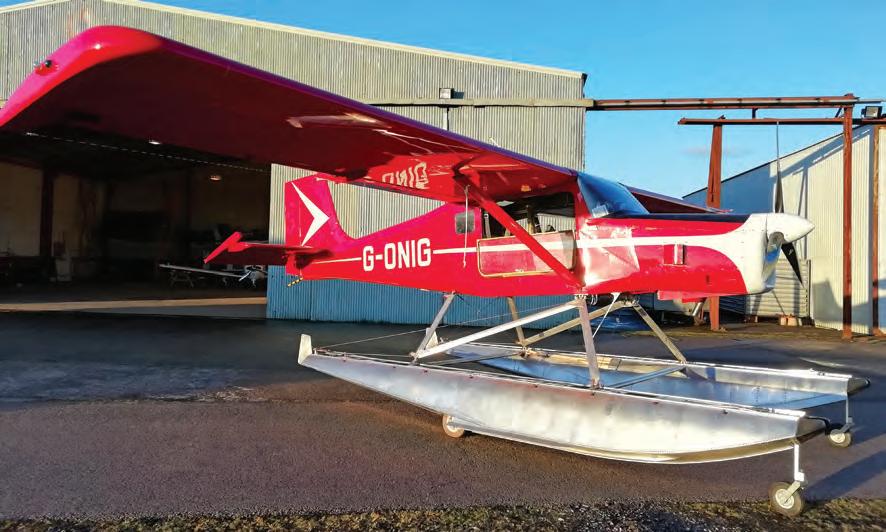
By Tony Roddam
Project Wing and a Prayer kicked off in late 2014, with the order of the wings, tailfeathers and slats of a Zenith CH750 STOL – I had big dreams but a small bank account, so have had to order and build the US kit in instalments over the years, which has not between without its challenges in a post-Brexit world.
A mere six years later I’m definitely turning final, or at least on the downwind leg, with the fuselage ready for final assembly, some parts actually finished in proper paint, and most of the components needed for completion in various boxes in the workshop. Except for the engine and instruments that is, but you can’t have everything… and if you anticipated every issue and planned for every contingency, you definitely wouldn’t build a kit aeroplane. Sometimes you just have to step off that ledge and hope it works out – so that’s what I did.
In fact, a lot happened in those six years I hadn’t foreseen – for instance, marriage was an unexpected delight, but I could have done without acrimonious
Above Early
Left Transformed, the taildragger becomes a floatplane.
redundancy, two business failures, and illness – all of which got in the way of real life, aka building an aeroplane. I’m sure most builders have similar stories and I suspect, like me, their aeroplane builds have kept them sane and motivated.
I love building the Zenith – the kit has proven straightforward to assemble, even if the learning curve has been near vertical for this PR manager. I am no media luvvie though – I can build an IKEA wardrobe, which must qualify me for Mensa.
I am reasonably practical, enjoy learning new skills and like puzzling out the various bits of the build. Handy, as a house move and getting married meant I’ve had to build two workshops, and I still can’t believe how much woodwork is involved in building an all-metal aeroplane.
Progress has been steady, fun and without drama. Wings, slats and tailfeathers are all complete and went together well, with a bit of forward thinking, some cunning jigs, and patience. Fuselage front and rear
are now fixed together – which went surprisingly well – all the right holes lined up nicely, and the whole thing fitted easily to the Tonka Toy maingear. This beast is very robust.
The Zenith airframe is a straightforward build and the instructions are decent, but you are left well alone when it comes to the systems, as much depends on your engine choice. I’ve spent the last few weeks puzzling out the fuselage electrics, wiring, and brake and fuel lines. In the end I used conduit and ran shielded multi-core Tefzel wire pretty much everywhere, with Molex connectors on anything I think might need replacing at some point. I was surprised how much wiring I needed. I’ve opted for a marinestandard blade fuse system rather than circuit breakers and fitted as many lights and beacons as possible – I have a healthy regard for conspicuity.
It took some doing, but I managed to keep fuel and electrics as separate as possible – electrics down the
Below Instrument panel with iPad mount and recessed engine control switches, and centre console, which houses the blade fuses under a hinged panel. Photo: Tony Roddam

passenger side, fuel and brake lines down the centre, pitot lines and aerial on the pilot side. The Andair fuel pump, gascolator and return line are all accessible through a hatch, and one of my build rules has been to make everything simple-ish to replace if (when?) it goes wrong.
One thing I found very helpful was creating electric systems and fuel ‘manuals’ in Powerpoint. These really helped me get my head around electrical systems in particular – that aspect had seemed a bit overwhelming at first. In fact, overcoming trepidation is a big part of aeroplane building.
Things in the instructions that once scared me witless (tap a hole, bend a fuel pipe, do something twiddly with wire?) I now take them mostly in my stride. I’ve even started to enjoy spray painting, encouraged by my Inspector Simon Goozee to give it a go. He said, “It’s your aeroplane, you should try to do everything on it.” He’s right – it’s very rewarding, even


Fuselage on trolley for fitting stabiliser and rudder, with a vertical sighting bar on the cockpit crossmember. All square!
of cleco-ed fuselage and engine mount on wheeled crate for fitting of windscreen – the only poor-quality part in an otherwise excellent kit. It took a lot of nervy fettling with a heat gun, softwood pieces and oscillating saw on three days of hot weather to get a reasonable fit.
if the results are a bit erratic. I’ve used a fair bit of paint stripper…
Why the CH750 STOL? Even its most ardent devotees would admit it has a face only a mother could love, but I like the idea of driving a ‘Land Rover of the Skies’ and love the thought of strip flying. It also means every ding or ‘good enough’ bit that would utterly destroy a sleek Van’s RV-7’s credibility at the LAA Rally, will merely add to its agricultural off-road charm. That’s my excuse and I’m sticking to it.
The CH750 ticks a lot of boxes – I’m a big chap, and it has a very roomy and airy cabin. It’s all metal, built like a brick doodah, and can carry two propersized people with full fuel and a spare pair of pants. I like its quirkiness. It has mad slats, the tailplane is mounted upside down, and much of its design seems to have been nicked from the Fieseler Storch, one of my favourite aircraft.
Crucially, Zenith has a very good social media/ forum network from which I’ve learnt a lot and even proudly contributed some technical tips. I got brave and submitted three Mods to LAA Engineering to improve the fuel sender position, add wing access hatches, and fit better sliding seat mechanisms. I’ve enjoyed designing and redesigning the cockpit layout – the panel is on its fourth incarnation, I think. A mix of steam and digital gauges – I like round things with needles on them – and an iPad with SkyDemon to help find the way.
Support from Jonathan Porter at Metal Seagulls is excellent, and entertaining. He and his wife Patricia have made several useful innovations for the aeroplane, the biggest of which being the header tank for the injected FADEC ULPower engine that will eventually haul project Wing and a Prayer (I married a vicar) into the skies.
“When will that be?” people always ask, after “Have you lost your mind?”, of course. When it’s ready and I run out of bits to fix to it. Until that moment I will continue to plod along and appreciate each little step forwards.
If your aircraft has been featured in the New Projects list, please let Project News know of your progress at: projectnews@laa-archive.org.uk
n Van’s RV-14 (LAA 393-15765) 28/4/2021
Mr N Shorter, Winser Cottage, Kingsford Street, Mersham, Kent, TN25 6PE
To Fly
If your aircraft has featured recently in the magazine and has subsequently completed its maiden flight, Project News would like to hear from you at: projectnews@laa-archive.org.uk
n G-CLCL Van's RV-7 (LAA 323-15313) 30/4/2021
Mr Robert Powell, Yearling, Green Lane, Pangbourne, Reading, RG8 7BG
n G-DAZW Zenair CH 750 Cruzer (LAA 381A-15597) 13/4/2021
Right My father sweeping the workshop after we wheeled out the purpose-built wing support trolley. Storage space is a permanent challenge. Photo: Tony Roddam
Middle right Tight squeeze! The assembled fuselage just fits diagonally across the double garage. I created an internal spray room in the garage from wooden battens and heavy polythene, which can be extended into the driveway for a full size spray booth. Really helps keep the place warm in winter too.
Photo: Tony Roddam
Bottom right The crate on wheels, great for building on, becomes a cowboy waggon for moving house and storage.
Photo: Tony Roddam

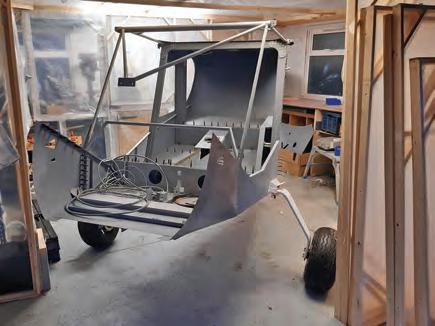

n Europa (LAA 247-15761) 7/4/2021
Capt. D Shipley, Cortijo Roan, Rambla Grande 126, Huercal Overa, AlmerÃa, 04600, Spain
n Van’s RV-14 (LAA 393-15764) 16/4/2021
Name & Address held by LAA Engineering
n Aeroprakt A32 Vixxen (LAA 411-15762) 15/4/2021
Name & Address held by LAA Engineering
n Van’s RV-8 (LAA 303-15763) 15/4/2021
Name & Address held by LAA Engineering
n Denney Kitfox MK 7 Supersport (LAA 172D-15760) 6/4/2021
Name & Address held by LAA Engineering
Mr Darren Weston, Springbank, 27 Lakeland Crescent, Leeds, LS17 7PS
n G-OGAL Van'’s RV-14 (LAA 393-15492) 19/4/2021
Ms Monica Wyer, 116 Milton Road, London, W7 1LE
n G-RVJS Van’s RV-8 (s/n 82237) 15/4/2021
Mr James Stringer, 1 Knoll View, Standon Green End, High Cross, Ware SG11 1BS
n G-CLNI DHC-1 Chipmunk 22A (s/n C1/0617) 28/4/2021
Name & Address held by LAA Engineering
n G-DGON Taylor JT.2 Titch (PFA 060-3233) 20/4/2021
Name & Address held by LAA Engineering
n G-IDID Bulldog Series 120 Model 121 (s/n BH120/348) 29/4/2021
Name & Address held by LAA Engineering
n G-MRKM Carbon Cub EX-2 (s/n CCK-18651023) 27/4/2021
Name & Address held by LAA Engineering
Wilson
With the LAA England Tour scheduled for early July, this is the last opportunity to bring you up to date on arrangements. Since last featuring the Tour in the magazine, much more detail has been finalised and it is not expected that there will now be any significant changes.
A briefing will take place each morning which will include the weather forecast, NOTAM and any specific requests made by the air traffic services whose zones we will be flying to, or near, during the day.
Please PPR all airfields that you intend to visit and stay at overnight, as it will help with ATC and numbers for meals. Please tell them you are with the LAA Tour.
Any landing fees, accommodation, fuel etc needs to be paid for and arranged by yourself. Evening meals and breakfasts at the overnight airfields are all payable by the participant.
4 July: The Tour will start to gather at the Meet the LAA Day and Wessex Strut Fly-in at Henstridge on 4 July, where there will be a FREE landing. People can stay overnight as camping will be permitted and there will be a cooked breakfast available the next morning. There will also be an engineer on site in case anybody requires technical assistance.
5 July: Following the briefing we head off from Henstridge to Bodmin, where again there will be a FREE landing. This will be the second overnight stop and camping is allowed, plus evening meal and breakfast arranged. This will also give people the chance to fly down on the Monday if they cannot make Henstridge on Sunday. Dunkeswell is available as a lunch/coffee stop en route and Devon Strut members will on site to welcome us. Please show your LAA membership card for a half-price landing.
En route info: Exeter Radar request you call for a Basic Service on 128.908. If non-radio, please buddy up with someone who has a radio and fly in loose formation if possible. Newquay ATC asks that you make an early call before Oakhampton when en route to Bodmin.
6 July: Head for Barton (£5 landing fee) for the next night stop, which again gives people the chance to join up as we fly north. Once again camping will be allowed, and an evening meal and breakfast will be available. The North West Strut members have offered to provide lifts to nearby hotels.
Cotswold Airport (Kemble) is available en route as a coffee stop and we will be joined by both Bristol and Gloster Strut members. Shobdon are also looking forward

to us stopping for lunch, and when we stopped there five years ago on our previous tour they really looked after us. If you are intending to stop there, please PPR so they can let the café know for food numbers. Shobdon Strut members will be on site to welcome us and if needed, help with any maintenance.
En route info: Cardiff request you to file a flight plan if routing through their airspace please – SkyDemon is suggested as the easiest way to do this. Bristol suggests that we transit south and east around their zone, using the Bath Corridor – please use their 5077 Listening Squawk and monitor 125.650.
Brize Norton Zone has been very helpful, as have all the ATC units that I have contacted. They ask that we squawk 3727 or 7000 – Brize LARS is 124.275 and their zone 119.00. If travelling together as a group, only the lead aircraft need to call.
Manchester Zone: Please observe the Manchester low level route, maximum 1,300ft height on the Manchester QNH. See Barton website for more details. Squawk 7000.
7 July: Head north-east to Eshott for a BBQ lunch and a FREE landing. The airfield operator will get their collection of old aeroplanes (as seen on the TV series Warbird Workshop recently) and vehicles out for us to look at. Then it’s down the coast to Breighton for a night stop (FREE landing). We will also be able to see the wonderful collection of old aeroplanes based with The Real Aeroplane Company. Camping permitted and an evening meal and breakfast will be served. Both Vale of York and LiNSY Struts will be joining us.
En route info: As with our previous tour, Newcastle ATC is aware and ready to help, so please call when you see the city bridges on the Tyne.
8 July: On to Leicester for a FREE landing, plus have lunch before heading home. LAA member and airport director Michael Wright is very much looking forward to seeing us, and the East Midlands Strut will be on hand to offer assistance if required.
En route info: Doncaster/Sheffield ATC is aware of our intentions of flying south and Waddington ask that we keep west of their area – they also control Scampton where The Red Arrows may be airborne up to 9,500ft, so
LAA Project Registration
Kit Built Aircraft
Plans Built Aircraft
Issue of a Permit to Test Fly
Non-LAA approved design only
Initial Permit issue
Up to 450kg
451-999kg
1,000kg and above
Permit Renewal (can now be paid online via LAA Shop)
Up to 450kg
451-999kg
1,000kg and above
Factory-built gyroplanes (all weights)
Note: if the last Renewal wasn’t administered by the LAA an extra fee of £125 applies
Modification application
Prototype modification
Repeat modification

Above Camping is an option at all overnight venues with evening meals and breakfast available.
Opposite You can’t beat a wellorganised BBQ and a convivial evening with friends.
please give them a wide berth.
The above information, we hope, is a good guide but remember, ALL pilots are responsible for their own aeroplane, route and flight. If you are registered as a participant, look out for emails with more information, although all of what is planned is mentioned above.
Please remember to PPR Henstridge via email nearer the time for their fly-in and tell them if you plan to join us there on the Sunday night for the tour so that they have an idea for both evening and morning meal numbers. contact@henstridgeairfield.com
Also, please check the LAA website for any last-minute messages in case Covid-19 regulations force route changes or cancellation etc. If you haven’t registered an interest in joining the Tour, you are welcome to do so at neil.wilson@laa.uk.com
Hope to see you all in early July. Fingers crossed for good weather! ■
£300
£50
£40
£450
£550
£650
£155
£200
£230
£250
minimum
£60
minimum
£30
Transfer
(from C of A to Permit or CAA Permit to LAA Permit)
Up to 450kg
451 to 999kg
1,000kg and above
Four-seat aircraft
Manufacturer’s/agent’s type acceptance fee
Project registration royalty
Category change
Group A to microlight
Microlight to Group A
Change of G-Registration fee
Issue of Permit documents following G-Reg change
Replacement Documents
Lost, stolen etc (fee is per document)
Latest SPARS – No 17 April 2018
£150
£250
£350
£2,000
£50
£135
£135
£45
£20
PLEASE NOTE: When you’re submitting documents using an A4-sized envelope, a First Class stamp is insufficient postage.
A brilliant Barton birthday for Ernie Horsfall, who has turned 103. By Graham Clarke and Cliff Mort
There are hundreds of LAA members who have very good reason to cheer Ernie Horsfall and raise a glass to congratulate him on another birthday, this time his 103rd.
On 24 April the LAA North West Strut and Jodel pilots from as far as Goodwood converged by car, Jodel and campervan on Manchester’s historic Barton Airfield – the first municipal airfield in the UK – to do exactly that.
If you have ever flown a UK-registered Jodel, you have reason to cheer Ernie Horsfall, who spotted that the French were disposing of their wooden club machines in favour of Government subsidised modern alternatives. Here in the UK, sport fliers hungered for affordable, simple and efficient light aircraft for strip operation. Enter Ernie, to acquire the French cast-offs and register them in the UK for British enthusiasts.
Ernie is still an LAA Inspector, and a few days before his 103rd birthday signed off another LAA aeroplane. He also remains active as an engineer and plans to renew his certification for another year!
At the Barton birthday celebration, the North Western Strut chairman, Cliff Mort, put a wrapper around Ernie’s enormous contribution to light aviation. He said: “I first met Ernie nearly 50 years ago when he was just a young lad. As you can guess I was even younger and almost just out of short trousers. It was in fact 50 years ago that Ernie had the idea of creating the North Western Strut. So, in 1971, after a shaky start, it came into being and has continued ever since. To my regret I was not one of the originators of this Strut.
“I now realise as I sat down to write this, that where Ernie has led I have followed. He was the chairman of the Strut – so am I. Ernie joined the committee of the PFA, and so did I. So basically, Ernie was my mentor and all I have to do now is reach 103. Well, I am trying, some say ‘very’.
“We come now to the reason why I am here, apart from helping him eat his cake. Ernie has previously been awarded a Bronze Medal by the Royal Aero Club, plus the Old and Bold Trophy, so this year was proposed by the Association for a Silver Medal for services to sport flying, which I am sure we all agree he thoroughly deserves.
“Ernest J Horsfall it gives me great pleasure to present you with the RAeC Silver Medal.”
EJH countdown…
3000: No, not the year BC when Ernie was born, but number of hours in logbook. Considering the average GA
Right Ernie had a great day at Barton with many fellow Jodel enthusiast’s, young and old, present.
Below Ernie was presented with his much-deserved RAeC Silver Medal for services to the LAA and Jodel community.


pilot flies less than 30hrs per year, it’s as if Ernest has been a pilot since the age of three!
1940: The year Ernie joined the Army to help win WWII.
1918: The year the Red Baron was shot down on the Western Front in WWI, and the year our own flying ace, ‘Ginger’ Horsfall, was born – on the same day, and just a few hours later.
1680: Number of Facebook comments for Ernie following his appearance on a national TV news programme in November 2019 for his send-off to the Festival of Remembrance.
104: Not Ernie’s age – yet, but two F104 Starfighter jets that intercepted him when, in the 1970s he flew from then communist Yugoslavia to Italy – without telling anyone!
103: Well, need we say more? An amazing 103 years of age and as bright as a button.
96: Ernie is LAA Inspector number 96, still active with a new-build aircraft two years ago and a microlight aircraft inspection just last month.
56: Number of Jodels he has owned, built, rebuilt, flown and sold – and a number of them were at Barton for his birthday bash.
6: Number of years Ernie spent as volunteer prison visitor at Leyland. And warders used to say that when Ernie visited it was hard to tell him from the inmates!
5: Number of logbooks Ernie has, to tell the tales of his 3,000 hours.
1: There’s only one Ernest John Horsfall, So LAA Members, if you happen to see the one and only EJH at the LAA Rally in September, pause a moment and give him a huge THANK YOU! ■









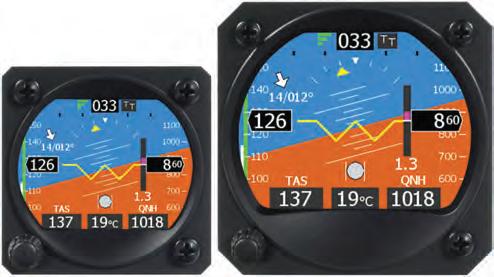

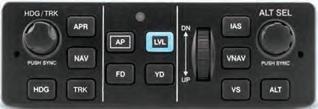












Hopefully, the aircraft were all still usable, everyone managed to get airborne, and those first few flights weren’t as traumatic as they could have been. The skies should be a little safer now than a few weeks ago, as pilots gradually get back into the swing of things. After not having flown for so long and due to the backlog, most instructors have been rushed off their feet, inundated with currency checks and instructional flights. Personally speaking, I must have flown from half the airfields in the South East and done enough circuits to get dizzy – no complaints though, it’s better to be doing lumps and bumps with rusty pilots with seemingly suicidal tendencies than not flying at all.
Last month’s highlight for me was the Vintage Fly-in at Compton Abbas, one of the few events that hadn’t been cancelled. Understandably, many were put off by the forecast and, generally speaking, the thought of showerdodging for three hours would not hold a great appeal, but under the circumstances, it proved to be a good day out.
As an event, it was low key, but as a chance for a bit of normality, it was a great start. Covid precautions were in place, food was served outside, but unfortunately the public were not allowed airside. However, it was an indication of things to come, the start of a return to life as we knew it.
Above Pembrokeshire has a magnificent coast with secluded beaches and the 186-mile Coastal Path for the more adventurous.
In last month’s magazine excursion, we travelled to the eastern coast of Britain and the last stop before the North Sea and Holland, Beccles. In an attempt to maintain a Parnassian balance, it seems reasonable to head for the western coast in this issue, and one of the last bastions before the Emerald Isle, Haverfordwest.
Generally speaking, Haverfordwest, or Hwlffordd in Welsh, has been a stepping-off point en route to and from Ireland. My partner Sian’s name is Welsh, the equivalent of Jane in English, Siobhán in Irish and Sheena in Scottish, so she feels a connection with the friendly nature of the people and the country in general.
My first landing at EGFE was at a time when things were new and full of wonderment. To describe things as exciting, thrilling and downright scary all at once is an understatement and doesn’t do justice to the mix of high-octane emotions. Articles such as these would fire the soul and stir the spirit but the reality appeared, to a neophyte like me, that they were the preserve of real aviators, an elite group to which access was ostensibly denied. Apart from a few club trips that served as a great introduction, this was the first real foray as a ‘big boy’ with a group of experienced pilots. With no instructor or mentor to hold your hand, anxiety levels were high, although the guys surrounding me displayed an enviable equanimity. In seeking advice from the most seasoned aviator within the

group, his answers were aphoristic and casually dismissed as he held the belief that experience was something to be earned and a baptism of fire was the best learning tool.
Simply rubbing shoulders with these gurus made me feel much like the young ‘wanna be’ gunslinger that trailed Yul Brynner, Steve McQueen and the other gunfighters in The Magnificent Seven
Having traversed the UK horizontally and on reaching this far-flung outpost of the British Isles felt an achievement for a pilot with around 100 hours P1, and the call for a drink, a meal and bed beckoned. My compatriots, however, had already made the decision to continue before an approaching front, so without time to lose, on we went. We managed to cross the Irish Sea before the first diversion and, without realising it yet, the experience building exercise had begun. It is said that ignorance is bliss and for the time being, at least, I was in awe of these masters of the sky! The result was a few soggy days in Ireland, followed by a return to Haverfordwest and a night in a damp, disused caravan on the airfield courtesy of the owner, there being no ‘room at the inn’.
After this first taste of the ‘forbidden fruit’, instead of it being off-putting, the addiction grew to eventually become a way of life, similar in some respects to the fervour I imagine is felt by some religious zealots.
Oddly enough, each time I visited this particular airfield, there was a calamity or unexpected occurrence of some kind. On one occasion, the trimmer stuck fully aft on departing Kilkenny and the Irish Sea was flown pushing forward for dear life. Landing back to sort out the issue wasn’t an option. On another occasion, the gascolator bowl developed a leak dispensing fuel over the cowl, not exactly the best situation before a sea crossing. Amazingly, the farmer found another from an old aircraft at the back of a hangar, and off I went.
My next encounter with Haverfordwest, or with pilots based there at least, was at an RV fly-in at Nuits St Georges. The Jodel and I managed to slip into the gathering in stealth mode as these RV pilots aren’t as canny as they think. We negotiated their lines and it
Left Haverfordwest Airport has had a deal of investment over the last 25 years.
appeared that no one had noticed the bent wings, lack of speed and, I must say, the rather elegant design. The evening was spent holding the ‘wood and fabric’ end-up with friendly banter while debating the epicurean merits of Burgundian food and wines. The contention of words continued well into the night and, although vastly outnumbered, I don’t recall a clear winner and the invitation to visit my new pals was accepted.
If you’ve never been to a fly-in dinner at some far-off destination, you owe it to yourself to go, if only once. You’ll find a group of people who may or may not have met before, who just seem to gel with what can only be described as convivial camaraderie. They can chew the fat to rival even the best chatterbox, although the subject matter is somewhat limited to food, wine, flying and, naturally, aviation in general.
With a population of a little over 12,000, Haverfordwest’s name originates from the Old English word ‘hæfer’, and means ‘ford used by heifers’ or ‘ford used by goats’ depending on which expert you’re talking to. The ‘west’ part was added later, in the 15th century, to differentiate it from the town of Hereford and appears on a 1578 parish map of Pembrokeshire as Herfordwest.
The Norman castle was built by Gilbert de Clare, Earl of Pembroke and sits high up in the town. Before the arrival of the Normans, putative opinion is that a Danish settlement existed on the site. Many Flemish mercenaries that accompanied the Norman invaders found something appealing and chose to settle in the area, an unusual decision for these soldiers of fortune.
Centuries later, it had become a Royalist stronghold and letters discovered as recently as 1986 from Oliver Cromwell to its inhabitants threatening annihilation, saw the castle’s destruction. In 1779 it changed use to become a prison, and these days it houses the town’s museum.
The Propellor Café: At the airfield, serving typical café food. 07580 533673 https://tinyurl.com/v8v5bwpf
Ell’s Kitchen: A simple lay-by caravan, serving tea, coffee
and the usual roadside fare, with a good reputation. A 15-minute walk away, turn left out of the airfield.
The Green Shed Café: Is a 20-minute walk from the centre of town out towards the south-west and recommended for a good hearty meal. Old Hakin Road, Merlins Bridge, SA61 1XF, 01437 700350 facebook.com/TheGreenShedCafe/ There are plenty of restaurants to be found around the river, but don’t expect fine cuisine. In general, you’ll be served pub grub, large portions, with a rustic take on things.
Below The picturesque Old Bridge in town crosses the River Cleddau and was built in 1726.
Bottom The ruins of an Augustinian priory contain Britain’s only mediaeval ecclesiastical gardens.
Premier Inn: Haverfordwest (North/A40). A 20-minute walk towards the town, near the roundabout along the A40. It says from £36 per night, although I’m not sure how to get that price, as I’ve not been able to. Expect to pay around £65. premierinn.com
LLamedos: This is a self-catering apartment, approximately a 40-minute walk away. Once you pass Ell’s Kitchen, turn left past the industrial estate to duck and dive rather than taking the main road. Best let Google maps do the work: Crundale SA62 4DH. Around £70 per night. The County Hotel: Is in the centre of town and has just


been refurbished. It costs around £95 per night if you want the ability to cancel, if not it will be a little cheaper. All you can eat breakfast at £5 per person is popular and worth the price. Salutation Square SA61 2NB. https://tinyurl.com/yakmj2yb
Newgale Campsite: For a camping holiday by the beach. It takes about 30 minutes by train from the station, T11 TrawsCymru Connect, or 20 minutes by taxi from the airfield. Tel: 07539 906611 newgalecampsite.co.uk
Otherwise, there are plenty of hotels and Airbnb’s to suit most budgets.
Getting into town on foot takes the best part of an hour, but it’s only a 10-minute taxi ride.
Castle Tour and Museum: Wherever you are in town, it is dominated by the castle, making a tour of the grounds and museum almost mandatory. https://tinyurl.com/yf5c6srw
Picton Castle and Gardens: Was built by Sir John de Wogan in 1280 and taken over by the Phillips family during the 1490s. Sir John Phillips purchased a baronetcy for £1,095, when they were created by King James I in 1611 to finance his campaigns in Ireland. This gave him a rank above all Knights, apart from the Knights of the Garter and became a valued hereditary title. pictoncastle.co.uk/
Spitfire Museum: Is a bit of a misnomer really, as it’s a charity shop with part of Spitfire JG 668’s fuselage in the back. But it’s free to view and you may pick up something of interest while you’re there, which goes to a good cause. 16, Bridge St SA61 2AD, 01437 762 512.
welshspitfire.org/history
Haverfordwest Priory: Founded in 1200, the Augustinian priory suffered under the dissolution by Henry VIII. Excavations between 1983 and 1996 uncovered Britain’s only surviving ecclesiastical garden from the medieval period.
Little Haven Beach: There are many natural beaches and coves to choose from, I picked this one as it’s simple to get to. The 311 bus goes there, takes about 30minutes, and you’ll find the bus stop near the library.
Farmers’ market: For a sample of real local produce. Takes place on Friday mornings by the river.
Pembrokeshire Coastal Path: Also close by is the 186 miles of pathway, 14 harbours and 58 beaches, providing the stunning views and rugged scenery which Wales is known for. Some brave souls undertake the whole of the nature trail in one go, taking from 10-15 days, although for most of us, a day or so exercising those leg muscles is quite enough. If you have the time, try a leaf out of my book and pick up some Brownie points in the process. I ask Sian to pack a picnic and a bottle of wine and we walk for a while until we find a nice scenic spot to enjoy the impressive sights. The sound of the crashing waves and pollution-free Atlantic air do wonders for the auditory and olfactory senses.
For the not so energetic, or if pressed for time, the alternative is a pleasant amble along the riverside in town, passing through the deciduous woodland towards the Old Mill Grounds Nature Reserve.
Two bridges cross the River Cleddau and are aptly named the Old Bridge and the New Bridge. When Harri Tudur (Henry VII) arrived with his army in 1485, there was no bridge at all, just a ford for the river crossing. The construction of the Old Bridge was eventually financed by the Phillips family in 1726, with the New Bridge built by architect William Owen, over a century later in 1836.
At one time, a weekend in Wales would have
incorporated some amazing riding as the country has an abundance of equestrian centres, and considering the campestral nature of the land, it lends itself to a full gallop across the countryside. I must say though, at times, I felt more like a passenger atop 17.2 hands of a refractory, spirited animal, rather than fully in control. If you’re not a rider but like the outdoors, there is an inexhaustible supply of things to do, see and experience.
I hope you see there is no reason to settle for another local flight simply because there are more than three clouds in the sky, and then complain about the price of beans. It’s time to make that transition and join that actually not at all elite group yourself!
I am, for one, still filled with the wonderment of flight, especially when I go away with a pilot for a few days and watch a fully grown adult become just like a child at Christmas.
About 25 miles south east of Haverfordwest is the airport of Pembrey (EGFP) and, to round off this month's adventure, I thought I'd share an interesting story about a Luftwaffe pilot who ended up landing at the wrong airfield during the war. On 23 June 1942, Oberleutnant Armin Fabar of the 7th Staffel, flying a Focke-Wulf 190 (FW-190) took part in a fierce dogfight over the English Channel. A total of seven Spitfires were shot down in the fire-fight, with a loss of two FW-190s. Faber found himself hotly pursued by Czech pilot Sergeant František Trejtnar of 310 Squadron. In a moxie move, Faber managed a nifty Immelmann Turn, emerging out of the sun to shoot Trejtnar down near the village of Black Dog in Devon. Now totally disorientated, he somehow mistakenly confused the Bristol Channel as the English Channel and, on spotting an airfield, waggled his wings to denote his victory to the waiting groundcrew. On landing, he discovered that instead of being in France, his host was RAF Pembrey and he was promptly arrested by a Sergeant Mathews armed only with a flare gun. His capture
Below Haverfordwest Castle dominates the town and is now the site of the Town Museum.
and interrogation were significant, as this was the first intact FW-190 to fall into allied hands and could be studied for weaknesses. Faber was eventually sent to Canada as a POW, returning to Shoreham Aircraft Museum 49 years later, where parts of both his aircraft and the Spitfire he shot down were kept on display. He, in turn, presented them with his pilot’s badge and officer’s dagger as a humble addition to their collection.
A question I’m often asked is, where is your favourite airfield? Or how do I decide on which airfields to visit? Sometimes, it is the direct result of a fly-in or a diversion. At times, it's due to an invitation extended by an airport manager in an attempt to promote their facilities. But the majority of the time, a tiny spark ignites curiosity and, much as I am aware of the oft used saying that ‘curiosity killed the cat’, I firmly believe that ‘satisfaction brought it back’! ■
Martin Ferid is a Class Rating Instructor / Revalidation Examiner and specialises in taking qualified pilots for confidence-building flights in their aircraft throughout Europe and the UK. These amazing experience flights are there for taking day trips or for a few days at a time.
A browse through over 150 ‘favourite destinations’ on the website below must provide inspiration for the experienced pilot and the newbie.
For amusement, try the ‘bit of fun’ section on the ‘contacts’ tab.
Whether it’s a simple confidence boost, a biennial flight, or just to do some distance flying.
Email: lightaircrafttraining@yahoo.com
Tel: 07598 880178
Website: http://www.lightaircrafttraining.co.uk

Last month we considered preparing ourselves for possible deteriorating weather. But what about contingency planning when it comes to airspace, particularly if one becomes ‘temporarily unsure of position’? A recent CAA Skywise communication tells the unfortunate story of a pilot who had done everything right in terms of his pre-flight navigational planning, but then infringed controlled airspace after misidentifying a navigational feature and changing heading too early.
Similar mistakes have probably happened to all of us, it certainly has to me more than once, but fortunately with less embarrassing outcomes. I’d like to express my thanks to our CEO, Steve Slater, for suggesting the main features of this article.
Aerial navigation is considered by many these days as being pretty easy, almost to a man most pilots have some form of GPS-based technology to show them the way, with tablet-based moving maps probably being the most popular piece of kit.
If we load our plan into a navigational device, a glance at the display will give us confidence that we are following that plan. Even if we do not load the route, a moving map can still provide good positional awareness, although we need to understand what it is telling us, and an up-to-date database is pretty essential unless we can relate everything directly to our chart. This is as important for local flights that are not planned as deliberate cross-countries, but which have resulted far too often in airspace infringements – instructional flights are especially vulnerable. In the worst case, even a mobile phone can provide some positional awareness from its map software if absolutely necessary.
However, over-dependence on an electronic device also comes with the risk that these wonderful devices may ‘die’ at the most inopportune moment, or that glare may prevent us reading the display. Even if we have loaded our route on a dedicated Sat Nav, we should keep an up-to-date manual ‘Plog’ record of headings, waypoints and timings on a kneepad, and/ or written on our chart. That not only provides a contingency back-up but should also provide additional situational awareness to help us avoid trouble in the first place.
Of prime importance however, whether using electronic technology or a chart, is the planning of the route itself.
The consequences of inadvertently entering controlled airspace are serious, so we need to do our best to avoid that, and we should start at the planning stage. It may seem obvious that if our route takes us a long way away from controlled airspace, we are less likely to infringe it. However, in the UK’s congested airspace we are seldom any great distance from a potential infringement. The Roman Army had a policy that their roads had to be straight and at the same time keep to high ground, which were conflicting requirements in many parts of the UK. As GA pilots planning our route, we have a similar conundrum. We need to avoid notified airspace, and at the same time make our navigation easy by using features which are difficult to misidentify.
When routing near controlled (or any notified) airspace, the risk of unintentional infringement is demonstrably reduced when pilots plan to remain clear of the horizontal and vertical boundaries of the airspace by a suitable distance that’s appropriate for them, their aircraft and the prevailing conditions.
The ‘Take2’ concept is easy to understand and great as a starting point, but we should not try to stick to it literally. I contend that planning to fly only 200ft below controlled airspace does not allow enough space for a pilot to safely avoid it. Convective updraughts can cause even the most competent light aircraft pilot to gain 200ft of altitude very rapidly, and a pilot concentrating on preventing that altitude gain is unlikely to be able to give the necessary attention to collision avoidance. I suggest we should aim for a vertical gap of at least 400ft, if that is a feasible option.
Planning to avoid notified airspace horizontally by passing to the side of it at a distance of two nautical miles should give us a relatively safe margin for error, but it only takes a matter of a minute or so to cover that distance and become an infringer if we head directly at it. Any plan which routes us directly towards notified airspace before turning really requires a greater margin than two nm to give time to realise a mistake in the event that we miss our turning point. We also need to manage the threat of misidentifying a waypoint and turning early towards airspace we had originally planned to miss.
Perhaps, if our next turn will be to the left after passing some notified airspace, we could consider leaving a greater gap on our left than on our right, even if there is a hazard on that side also?
Sadly, in the UK, it is often not possible to keep
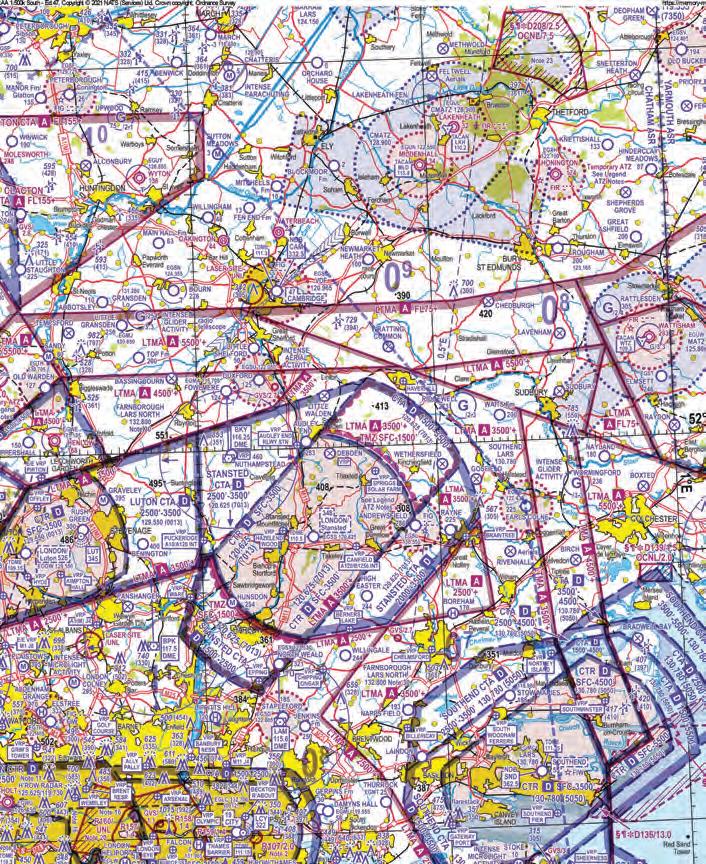
even two miles away from every piece of notified airspace without increasing the risk in other ways. However, we should also be trying to reduce the risk of misidentifying a waypoint in other ways. Studying the chart (an up-to-date one of course!) may seem an obvious solution, but trying to identify small details can actually be counterproductive, and not only because it reduces time available for collision avoidance. Keeping things simple makes life easier, so I plan to fly in a few long straight lines if I can (see Map A). I may need to work at my navigation for a short while, but once I have sorted out the heading which gives me the track which I need, and confirmed my ground speed, I can continue knowing my plan will work out. Constantly changing direction leads to confusion and increases the risk of error.
I always try to select relatively unique and easily seen features as my waypoints and try to describe them to myself (and my passengers) as I expect to see them, both before take-off and while looking for them in the air. On Map B for example: ‘A town with a dual carriageway bypass before it (Alton) – I want to be a mile left of the left edge of the town, left of a roundabout on the bypass to be sure I avoid the gliding site (Lasham)’. My next waypoint may be: ‘A bigger town again on my right (Basingstoke) – I want to cross a motorway where a dual carriageway leaves it, passing left of a village beyond it (East Oakley)’. If I can see I am travelling towards the main feature of my next waypoint ahead (ideally about 10 miles away) before passing the previous one, I can feel pretty confident that I am going to remain close to my planned track.
Choosing such waypoints is not always easy, but I usually try to adjust my route to include some good ones by selecting an easily identified ‘start point’ away from my take-off airfield. I may also add an extra turning point to my direct route to provide better

Above There is less risk of infringing if you plan to fly as straight a route as possible. Photo: Crown copyright
Left Select waypoints with several identifying ground features so they are as unambiguous as possible. Photo: Crown copyright.
features to use as waypoints, if the change of direction is less than 30° I won’t sacrifice much time or fuel.
Unfortunately, the 1:500,000 charts have so much information marked on them that useful visual features are often obscured by essential airspace descriptions and boundary markings, aerodrome or navaid frequencies, or VRP names.
The 1:250,000 charts tend to have more space to see ground features (partly because they do not include airspace above 5,000ft), so I usually refer to one of them during my pre-flight planning. If my ground speeds are below 90kt and I’m remaining below about 4,000ft, I’ll navigate using a suitably folded quarter million chart in the air as well, but I always also carry, and refer to, a current half million.
At higher speeds, or for longer journeys, managing a larger scale chart in the cockpit becomes awkward and I just have to try to remember what details are hidden under the marking on the 1:500,000 chart.
3. Get the strength of the ATS around you
At the planning stage, we should note all the frequencies which might be useful, and check Notam to make sure they are available (we did check for navigation warnings as well, didn’t we?). Although there is no requirement to use our radio outside controlled or specified airspace, it is good sense to take advantage of facilities which are available. If the ATC unit which controls the airspace we are passing knows we are there and what we intend doing, it gives the controller confidence that his instrument traffic is safe. It also means if the controller sees us getting close to controlled airspace, he can advise us how best to stay outside.
Unfortunately, often once airborne, the frequencies are very busy, and we can’t get a word in edgeways. In that case we can select the ‘listening squawk’ to let the controller know where we are and that we intend staying outside their airspace, giving them the opportunity to warn us if we get too close.
I know it can seem daunting to talk to a controller, who it is easy to think must be some kind of superhero. To a VFR pilot’s ear, it is almost impossible to understand the phraseology used between controllers and the airliners being controlled, mainly because it comes out so rapidly. How could we possibly understand, or make ourselves understood to such giants of the airwaves? Well, first of all, the controllers are trying to keep us safe, so they want to hear from us. We don’t need to use airliner code – we just need to speak clearly and say what we need to, following the basic principles we learnt for our RT licence (you can refresh yourself via CAP 413).
Secondly, if we don’t try, we never will! If you don’t feel confident to try yourself, there are Coaches out there who are more than willing to help you gain confidence in communicating with air traffic services.
Whether we misidentify a turning point, or realise we have been steering the wrong heading, or discover our heading indicator is faulty, at some stage we may start to think we are not where we should be.
‘Uncertain of position’ is the phrase, and we should not be shy about using it, especially if we have any reason to believe we are in the vicinity of controlled airspace.
Our aircraft may well be presenting a hazard to others, so we need to make those others aware of that fact, so we should select 0030 with ALT on the transponder, if we have one. We have an urgent message to transmit concerning the safety of an aircraft (even if we don’t know what aircraft that is) so make it: ‘PAN PAN, PAN PAN, PAN PAN, ( your own callsign ), uncertain of position near controlled airspace’. If we are in contact with the airspace controlling authority, or even if just listening with the appropriate transponder code selected, break in on that frequency.
If the controller is not expecting us to be there, select 121.5 MHz and make the urgency call to London Centre on that. The format of the message is of course part of the RT licence test, but no controller is interested in the format – only the information.
We may not have a radio, or it may have failed, or it may just be taking time to establish communication with ATC. We need to minimise the hazard we present, so we should turn away from the likely position of the notified airspace as soon as we realise we may be heading for an infringement. It sounds logical, but it’s hard to do in the heat of the moment. If we have no idea where the notified airspace is, it might be better to hold our existing heading or perhaps retrace our steps, flying a reciprocal heading to our previously noted waypoint on the plog. If we were tracking towards controlled airspace, a clearly defined turn away might also reduce a worried controller’s blood pressure!
It’s good to see that the CAA has issued further ORS4 exemptions (1484 and 1485) to extend the period in which we can revalidate our ratings with a little less experience than the ANO normally requires. These exemptions are now available until 31 July 2021. However, we need to stress that these exemptions do not extend the validity period of the ratings themselves. The expiry date written on the ratings page of the licence is the date by which the examiner, or Instructor, using FCL 945 privileges, must have signed it in order to revalidate the rating. If the rating cannot be signed by that expiry date, the rating must be renewed by passing a General Skills Test (GST) for the NPPL or a Licence Proficiency Check (LPC) for the PPL.
LAPL holders who have not completed the LAPL validity requirements may renew by passing a LPC, or regain the requirement under the supervision of a flying instructor, and of course that includes our Coaches.
It appears that several pilots and AMEs have experienced issues while using the CAA’s new ‘Cellma’ medical service, which was introduced on 29 March 2021. Consequently, and in order to provide continued service, we understand that the CAA is allowing AMEs to continue to use paper forms to complete medical examinations and issue medical certificates.
However, this facility only exists where pilots and applicants have completed the process for obtaining a CAA Customer Service portal account but find themselves unable to access the records system. ■


ANDAIR FUEL SYSTEM COMPONENTS COMBINE MODULAR DESIGN, SUPERB QUALITY AND THE FLEXIBILITY TO SUIT ANY AIRCRAFT BUILD PROJECT.



Having built a reputation for excellence in the design and manufacture of light aircraft fuel system components within the amateur-build aircraft sector, Andair has now established a significant presence in the commercial aviation market as well.
OUR PARTNERS:






Without specialist advice fixed wing and rotary pilots can often face significant premium increases when applying for life insurance. We can usually secure standard rates with no aviation exclusions.
• Life insurance for your family, mortgage or business.
• We help recreational, commercial, instructor and student pilots.
• Cover can be arranged over the phone.
• Our insurance advisor holds a PPL.
• Online quotes.

The ARV1 Super2 – an ambitious attempt at a British world-beater, as Clive Davidson reports… Pictures Neil Wilson

he ARV1 Super2 is a compact, all metal, dual-controlled trainer that was conceived in the mid-1980s to fill a slot in the market and cut the cost of initial pilot training. It was a bold British undertaking, a step into the realm which was pretty much dominated by the ubiquitous pair from our North American cousins at Piper and Cessna, the PA 28 Cherokee and the 150/152. It was innovative and pleasant to fly, however, any new airframe, also coupled to a new engine, has double the challenge to establish credibility, both in functionality and reliability.
The story begins with Scottish entrepreneur Richard Noble, who in 1983 had gained the world land speed record in the jet-powered Thrust2 at a speed of 633.468mph (1,019km/h). At the time, the American general aviation industry was going through a tough period with a spate of ‘no win, no fee’ litigation which threatened the viability of manufacturing light single-engine aircraft. Indeed, production of light training machines had all but ceased. Noble saw an opportunity to inject some life into the British light aircraft industry, which by then was ostensibly reliant on the new, but burgeoning, microlight market, by producing a purpose-designed light trainer. He engaged Bruce Giddings as chief designer, along with Nick Sibley, both of whom had experience in the microlight industry, and James Morton who had worked with John Britten (formerly of Britten-Norman) on his unfortunately unsuccessful Sheriff light twin, and established ARV Aviation Limited at Sandown on the Isle of Wight.
Their ARV1 Super2 prototype (ARV standing for Air Recreational Vehicle) made its first flight on 11 March 1985 and generated a great deal of interest. It was a smart looking aircraft, featuring strutted shoulder wings which swept forward, providing excellent visibility from the side-by-side cockpit with its rearward hinged, generously sized, Perspex canopy. It was built from a special British lightweight aluminium alloy called Supral using fewer rivets and bonded skins rather than the more traditional all-riveted technique. The cowling and wingtips were of composite construction.
Of particular interest was the 77hp (56Kw) Hewland AE75 engine, which was specifically designed for the aircraft. An inverted and water-cooled (via a belt driven pump) 750cc two-stroke in line triple, it featured dual ignition and triple carburettors. Rather surprisingly, it ran on a 40:1 petroil mix rather than using an oil injection system which, by the 1980s, had become the norm for high-performance two-stroke motorcycle engines.
40% less than a C152 and was promoted as cutting flight training costs by 25%.
Unfortunately, soon after the first customer aircraft were delivered, there were a number of forced landings due to gearbox problems caused by torsional vibration, ultimately leading to the CAA grounding the aircraft in November 1987.
The story goes that although the engine and gearbox had accumulated many hours in a test cell during the certification process, and successfully coped with the punishing programme of full power running, prolonged cruise etc demanded of it, what the gearbox objected to was prolonged slow idling, as for example during the hold while waiting for a procession of aircraft to land.
I was surprised to find that an old friend, Adrian Goodwin, did part of his training on a Super2 at a Bournemouth-based flying club. His overriding reminiscence is of enjoyment, similar I am sure to the majority of pilots for the aircraft they have learned on. However, he did hear a Mayday call from his CFI suffering ‘another’ forced landing with a seized engine. This was Derek Davidson (no relation) whose flying school had invested in the aircraft until the security of his students was no longer tenable.
The failures and grounding naturally caused customer and investor confidence to take a hit, and ARV Aviation was forced into receivership. A management buyout saw the company reborn as Island Aircraft, and with the gearbox issues resolved, a total of around 30 aircraft were produced before production ceased.
At least three other companies have intended to put the aircraft back into production, Aviation (Scotland) Ltd. in the UK; ASL Hagfors Aero in Sweden, which planned to call the aircraft the Opus and supply it with an 80hp Rotax 912; and Highlander in the US. With recent reports that the Luscombe Silvaire is, yet again, going to go back into production, who knows? The Super2 may yet rise phoenix-like from the unfortunate ashes of coming into the market just a few years before the Rotax 912, with which it may have proved to be a world-beater.
The aircraft is compact, offering just enough cabin space. It really was designed with training, rather than touring in mind.
The 2.7:1 propeller speed reduction unit (PSRU) featured helical gears running in an oil bath, with the Hoffman two-blade fixed pitch propeller being attached via a rubber ‘doughnut’ coupling.
The initial plan was to sell the aircraft as ready to fly, on a Certificate of Airworthiness, or as a kit of major components for assembly under the PFA Permit to Fly scheme. The aircraft undeniably had great appeal, it reputedly weighed
Only five aircraft were built from kits but in 2004 the remainder of the UK fleet were given the option to transfer from a CoA onto the Permit system. Production of the Hewland engine had ceased along with the aircraft, and with only an 800-hour TBO, it wasn’t long before various other engines were being installed, something of a challenge because the HE75 weighed in at an impressively light 49kg (108lb). Three aircraft were re-engined with the Midwest twin rotor Wankel, but a Nigel Beale (SkyDrive) developed Rotax 912 installation developed on this month’s review aircraft has inspired a number of follow-on installations including of the more powerful 912S and 914. Rotax’s flat-fours fit very neatly but, being heavier than the Hewland, generally require some tail ballast to preserve the CofG.
Designed principally as a training aircraft, baggage space is limited to a bay behind the seats with a maximum permitted 11kg load. The 912 increases empty weight to 333kg but this can be offset somewhat because it is possible to get the max all up increased from 499kg to 525kg. The engine is also wider at the front than the Hewland, so quite significant
changes to the cowling also had to be made. More recently, there has been an example with a neat installation of the more compact 80hp four-cylinder Jabiru 2200.
Paul Robichaud and his ARV
G-OTAL, the subject of this flight test, is finished in the standard red of the original factory aircraft and features the original Rotax 912 engine conversion, first issued a Permit in 1991 – indeed this was one of the first of any aircraft in the UK to be fitted with a Rotax 912. It had then been used to trial the Rotax turbocharged 914 before being re-engined again with the normally aspirated 912-ULS. Owner pilot Paul Robichaud acquired it in a rather tired condition about 18 months ago.
Paul had an interesting route into flying, having started with a Rotax 503-powered single-seat Benson gyrocopter. He learned to fly on the Benson, his instructor explaining how he
Below The exposed engine coolant pipes run back a long way to the underslung radiator.
Bottom Owner Paul Robichaud with his ARV. He is gradually bringing it back to a much tidier standard.
should travel down the runway at increasing speeds to get the feel of it, while he observed at a comfortably safe distance.
Eventually, Paul inadvertently left the ground, and by good fortune, came back down again with no harm coming to either man or machine. The instructor then introduced him to flying in a two seat RAF 2000, which he says bore little similarity to the Benson. With more practice he was soon flying the Benson, and accumulated 620 hours of gyro flying, most of it in an RAF 2000.
He then got the itch for fixed-wing and in order to get a Group A licence, all he had to do was fly with an instructor to a level that satisfied an Examiner, with that being a minimum of five hours. He did the training and test within 17 hours. Pretty good going. A tailwheel Pulsar was followed by a Rans S6 and a C150, and he now has the ARV.


One’s initial impression is that the ARV is quite a small machine, as you can see the upper surface of the shoulder wings, which puts the fuel tank filler, mounted between the wings, at a convenient height. Overall dimensions are 18ft long with a wingspan of 28ft and 6ins, the fin and rudder extending to seven feet seven inches above ground. With a gross weight of 1,100lb (499kg) it is easy enough to wheel around, making doubly sure first that the mag switches are off if pulling on the prop hub.
The wings have an unusual five degrees forward sweep, rather like the Bolkow Junior, and have a comparatively small area of 92.5 sq ft, which gives a wing loading at max all up weight of 11.9lb per sq ft. The aerofoil is a modified NACA 2415.
It’s always tempting to jump into the cockpit and sit in the seat that you will occupy, just so as to get a bit of a feel for the aeroplane, but today, with the canopy unlatched and hinged back, it is possible to lean into the cockpit and reach the various controls. It has an odd arrangement as the two sticks are in the shape of a ‘U’, which pivots at the centre, so the sticks have an off-centre tilt, or rather throw. This is just like the D11 series Jodels, so I expect one quickly gets used to it.
Standing beside the cockpit it is difficult to see the ailerons but, like the elevator, they are rod operated with no play within the system. Looking into the footwell, the rudder pedals are just that – with no brake activation system – the brakes being operated by a central lever on the central panel which may be pulled by either occupant. There is no differential braking, both of the hydraulic disc brakes acting in unison, the nosewheel though, has direct steering.
The flap lever is situated between the seats, with 0-, 25and 40° positions, the flap limiting speed being 80kt.
Right Baggage space is minimal, being 11kg max behind the seats.
Below The hinged backward canopy is substantial and features latches on both sides.


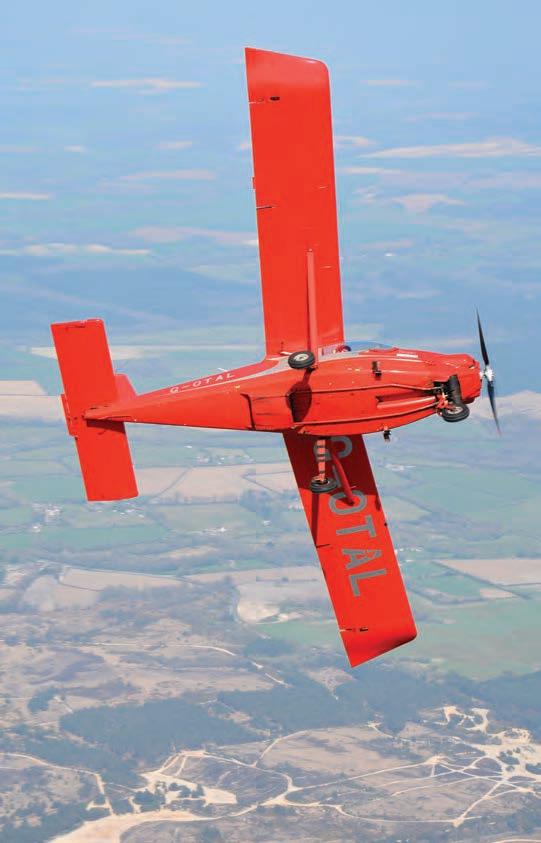
Left Handling is stable and predictable, with no odd quirks to unsettle an ab initio student pilot.
Right The empennage is pretty traditional. Note balanced, cableoperated trim tab and dorsal fin.
Below The aircraft remains attractive, although the design is now over 35 years old. It is a great shame it ran into problems and did not succeed.
Looking for handling clues, the ASI white arc starts at 45kt and the green arc at 52kt, so with flaps the ballpark approach is going to be around 65, perhaps 60, with a handful of power and helpful slipstream over the small surfaces when pitching and levelling off – we’ll have a better idea about that once we have done some slow flight at height.
The trim lever, I am told, is quite sensitive and is located on the centre console. Directly above is the circular fuel contents gauge, showing a full capacity of 50 litres, a Trig TX21 transponder, and above that a Dittel TQ radio. Higher still is the rpm gauge for the 100hp Rotax 912ULS, which promises good performance with a full 23hp over the original AE75 powerplant. It drives a ground adjustable three-blade Woodcomp Classic prop which Paul says is set at 17° but could perhaps be a little finer for better climb.


The throttle, carb heat and choke are mounted on the lower end of the centre console, so everything needed to fly the aeroplane is situated to be accessible by both occupants without duplication.
Placed in front of the P1 seat the original basic six instruments today have the benefit of an Avmap and an Aircrew Instruments Aircrew, which has three modes: it displays the conspicuity output from a PilotAware Rosetta or SkyEcho; it can be used as a direction indicator; or it can be an artificial horizon. Along the bottom of the RHS panel is a Rotax Flydat which takes care of the major engine monitoring requirements. To the right, the P2’s panel has a ball mount for an iPad running Runway HD nav software, and an easily accessible row of fuse holders along the top.
It shouldn’t go unnoticed that Paul has overhauled the panel since he acquired the aircraft, it was incredibly grubby and, testament to its development history, also had holes here and there where instruments used in its former life as an engine test bed were now missing.
Walking around the fluted wing tips, the ailerons may be gently cycled up and down showing their differential deflections of 20° up and 14° down. The cable-controlled rudder moves symmetrically 25° in both directions and, like the other control surfaces, is aerodynamically balanced while, unusually, the elevator mounted trim tab has a dinky little mass balance horn.
The spring steel undercarriage has gained some larger than original wheels and tyres, the original size being OK on firm surfaces but tending to sink into soft grass, unduly prolonging the take-off run. The nosewheel uses a combination of rubber bungees and a substantial suspension damper but works well, with no hint of disconcerting shimmy on this occasion – a service bulletin relates to shimmy problems occurring if the shimmy damper should become ineffective, the resulting violent thrashing about of the steering apparently causing tell-tale creases in the ARV’s rudder.
On the underside of the fuselage, the silencer partly
Below Paul’s upgraded panel uses a number of digital instruments, but is not too far removed from the original factory layout.
protrudes crosswise along the firewall, and two water pipes extend back to the radiator, which is located in a protruding ‘tunnel’ aft of the main undercarriage.
Before climbing into the cockpit, the standard Rotax oil ‘gurgle’ must be done by pulling the prop blades through sufficient compressions, before checking the oil level, securing the cap with a final twist of the wrist. The coolant system’s header tank, located on the firewall, can be checked at the same time.
Entry into the cockpit first needs the canopy to be unlatched and swung aft and back so that it rests against the stops of the extended gas struts, securely past the vertical. With clean soles and one foot on the fuselage-mounted step (avoiding grabbing the tantalisingly close canopy), swing the other leg up and into the open cockpit and support yourself with a hand on the coaming – there’s a convenient grab handle in the centre – then lift the other leg in and settle down into the seat.
I let Paul get settled and sorted in the left-hand seat before joining him, and buckled in with the lap and diagonal harness, then the canopy can then be brought down to lock shut. I wondered what might happen should we need to ditch, as you certainly couldn’t consider loosening the restraining latches on the canopy before hitting the water. But as we were not going sightseeing along the Jurassic coast today, with the sad sight of dormant cruise ships sitting off Bournemouth, thankfully I did not have to let that concern me.
The cockpit is snug, not best suited for ‘large’ occupants, but with the top down and locked there is sufficient room with our headsets on and the view is excellent. Twisting to my left I can see both above and below the leading edge of the wing, rather like on the Nord 854, which I was so taken with when we tested it back in June 2018. It should really help in retaining a good view of the camera ship.

Brakes on, fuel cock beneath the seats on, ignition – both off. Master on and voltage noted, throttle at idle, ‘Clear prop’ and a five second push on the starter to pressurise the oil system.
And now for the start proper, ignition on both, brakes still good, stick back, choke pulled out and a firm press of the starter sees the prop rotating and the engine quickly catching. A pause and the choke may be slowly pushed in and a 2,000rpm set. The oil pressure has a healthy showing, up within 10 seconds and looking for the starter warning light – yes, it’s out. After a couple of minutes, the rpm is brought up to 2,500-plus, we are waiting for the oil temperature to exceed 50° C and for David Frazer to call in over the RT from the photo ship, a Piper Pacer with Neil strapped in the back seat with a clear view out as the rear door has been removed.
Below The Rotax installation is certainly very ‘busy’, there’s not a lot of space beneath a Super2 cowling!
Bottom The highly modified original cowling with large cheeks to accommodate the wider engine and underside cut-out for the silencer.

At the hold, all is well with our 4,000rpm power check, the individual ignition drop being less than the maximum 300rpm allowed. The throttle is briefly opened to 4,600rpm and then slowly back to an idle of 1,500rpm before setting 2,000-2,500rpm.
We backtrack the active runway to turn around and await the positioning of the Pacer, which then takes off first. As soon as it breaks ground, we too commence our streaming departure. ASI live, rpm fine and a slight wing wobble as the ARV1 passes the point where the Pacer took to the air. On and upwards, we need to catch them, so we cut the corner and adjust our climb as required between height gain and speed to manoeuvre into position.
Outbound I sit low in the box, moving in and out of close, low proximity with variation of crossing controls and change of height, attempting to show different angles and aspects. Neil beckons me out, back, up and away. Concentration is all, nothing matters more than our relative positions in the sky as our aerial conductor places us in the sunlight. It is not the first time, nor probably the last, that I comment on the pleasure of movement of one aircraft beside another, gauging its relative reaction and control. I adore these moments and the little ARV1 slots well into the proximity of David’s Pacer as it is held skilfully steady in the air.
All too soon I am given the final break from the formation and feel I already know this shoulder hunching machine quite well. I was cranked slightly forward in my seat during the shoot but now relax right back into the seat, which has been neatly recovered since Paul has had the aircraft. Taking stock of the engine condition and fuel contents, I make sure Paul is still happy (he is) – so let’s try a couple of exercises to further ascertain her character. I have been flying her cross controlled a number of times and now, from steady heading side slips release first the ailerons watching each lowered wing rise in turn, confirming her lateral stability. Then releasing the rudder from similar steady heading side-slips, I observe the nose promptly returns to its expected and rightful place, so she is also directionally stable.
Trimmed out to the best of my ability in the slightly turbulent air, our max straight and level is 112kt with 5,500rpm


showing; Paul comments that he gets a variation of three knots at this, our max continuous power setting.
Bringing the power back to an indicated 100kt, a slight pitch down to gain a further 10kt and letting go of the stick, the little ARV1 searches in pitch for her starting height and speed, rising and falling three phugoids to arrive close to where the controls were let go, so she is also nicely stable in pitch as well. Economy cruise is at 80kt at an anticipated fuel burn of 15 litres an hour – that’s a three-hour endurance.
The most efficient climb speed is 70kt, well sort of as Paul says he gets the same rate at 80kt as well. Our near max weight and a climb speed of 75 with 4,700rpm gave us a rate of climb approaching 800ft per minute. On his last permit flight test, conducted solo during the Covid restrictions with an all-up weight of 475kg (so 24kg under max), the VSI at times showed 1,200ft per min, but it timed out at 1,000ft per minute.
Vne, velocity never exceed, is 126kt but due to the turbulence, we gave it a miss, not wanting to overstress the poor girl for no purpose other than to say we have done it. But at the other end of the scale, slow flight and stalls show good manners and prompt returns to full control.
Clean, without flap, she complains with slight stick shudder before the published stall speed of 55kt, whereupon we start a wings level, high rate of descent, the ASI giving a fluctuating reading. Control returns promptly with stick forward and a handful of power, balancing with the right rudder. The full flap stall exaggerates the stick shake, and when she lets go the left wing thought about dropping, but again all returned to normality with the stick forward, balancing rudder and power. We were in no danger of exceeding the flap limiting speed of 80kt.
Baulked landings and go-around practice proved absolutely no problem at all. The application of power raises the nose slightly to the left, right rudder easily catches this and, as we have seen from the earlier exercises, the sprightly little ARV1 is stable enough to fly away cleanly and reassuringly from a go-around. And of course, the flaps may be milked up as speed and height is gained, not wishing to induce sink.
Her circuit manners also hold no difficulties, having a downwind speed range that fits in with local traffic. A quick jiggle between the seats to lower the flaps and the approach
Above The swept forward shoulder wings cleverly allowed improved upward and sideways visibility compared to a traditional highwinger.
is flown at 70kt and brought back over the hedge to 65. It was easy to hold off for the flare but being a smaller aircraft, I could have done with being slightly lower as the sink was slightly farther than I anticipated, a slight burst of power gave the accommodating main wheels a brief respite before Alpha Lima touched down and ran straight on her mains, the nosewheel being easily held off and then allowed to lower.
I must admit to having enjoyed my flight with Paul, gaining an insight into an aeroplane that I had not come across in all my time instructing, but I am glad our paths have crossed, and I really appreciate its qualities.
How fortunate that the Rotax 9 series of engines has evolved to power so many of today’s light aircraft and revitalised this particularly delightful little character from a slightly earlier era. ■
Crew: Two
Length: 5.49m (18ft 0in)
Wingspan: 8.69m (28ft in)
Width: 2.54m (8ft 4in) (wings folded)
Height: 2.31m (7ft 7in)
Wing area: 8.59 m2 (92.5 sq ft)
Empty weight: 306kg (675lb)
Gross weight: 499kg (1,100lb)
Fuel capacity: 55L (12 imp gal; 15 US gal)
Powerplant: One Hewland AE75 3-cylinder liquid-cooled inline engine, 57kW (77hp)
Propellers: Two-bladed Hoffman fixed-pitch propeller, 1.60m (5ft 3in) diameter
Maximum speed: 190km/h (120mph, 100kn) at 610m (2,000ft)
Cruise speed: 153km/h (95mph, 83kn) at 610m (2,000ft)
Stall speed full flap: 102 km/h (55kt)
Vne 233 km/h (144mph, 126kt)
Range: 500 km (310mi, 270nmi) (with maximum fuel)
Rate of climb: 3.1 m/s (620 ft/min)
Take-off run to 15m (50ft): 712m (2,336ft)
Landing run from 15m (50ft): 470m (1,540ft)


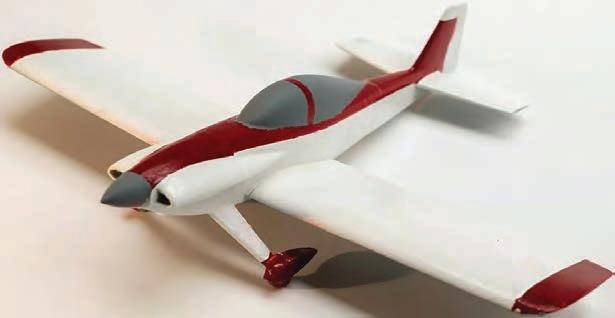
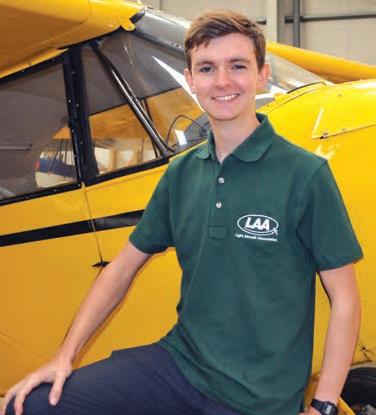
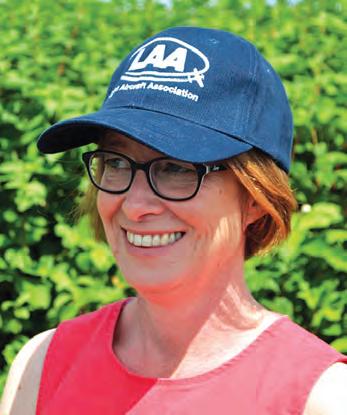
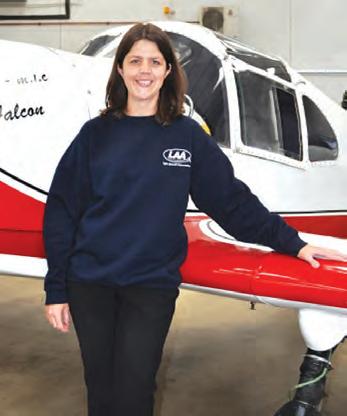



We are beginning to see the return of gatherings planned for the summer months in our Struts’ calendar, plus we are returning to our normal preoccupation when it comes to dates – the British weather! We are certainly due a dose of blue skies and balmy flying days.
As you will know, the Struts have been very active over the last few months in adapting to an ever-changing situation and recently we were able to ‘meet up’ at a Strut leaders’ Zoom meeting. It was good to see Strut representatives from Bodmin in the South West, to the North of Scotland at the meeting, which was held online in May. In all, nearly 20 Struts and several LAA member clubs were represented, and the evening was hosted by the LAA’s Strut Coordinator, David Millin.
Among the agenda items was an opportunity for leaders to share their Strut ‘lockdown’ experiences, and there was positive feedback regarding the use of Zoom for many meetings over the last year. It was felt that online meetings gave opportunities for a wider audience, and a more diverse selection of speakers sharing a broad range of subject matter of general interest. The format had also been used by many of the Member Clubs, including the Europa and Vintage Aircraft Clubs, which enabled members from abroad to share an evening with UK members as a social, as well as informative, event.

by Anne Hughes
Trevor Wilcock from the Bristol Strut had said previously, “Zoom is a poor substitute for our usual opportunities to chat at BAWA, but it has been useful in maintaining some cohesion and keeping members up to date with Brexit changes, and Covid extensions and exemptions over the past few months. It gives the opportunity for members of other Struts to join in – and for me to eavesdrop on other Struts! We have also enjoyed the company of Strut Secretary Mary Leader and her lovebird Pico, who is always happy to join in with a CHIRP report or Listening Squawk!”
Many felt that all the Struts and Clubs would use this format for some future meetings, but there is no substitute for meeting up in person, especially for fly-ins, and general social events, which will never be taken for granted again! It was also noted that some members were excluded from online events as the technology was not available to them.
Above Bristol Strut’s Mary Leader is often accompanied on Zoom meetings by her pet lovebird, Pico.
Below The Rally team is looking for volunteers, why not come early and join in the fun!
The LAA Rally will take place at Sywell 3 -5 September and is eagerly anticipated! However, not only is there a huge amount of forward planning, especially with the uncertainties regarding potential Covid-19 government guidelines, but the event relies on an army of volunteers for several days before and during the event. The Strut leaders were asked to ‘round up the troops’ from Strut membership to help with the set-up from 31 August. Camping facilities will be available and there is accommodation locally with plenty of opportunities to socialise as the team effort clicks into action.
There is also an opportunity for Strut members to volunteer in the Struts area in the new LAA village area, where the Strut banners will be on display, creating a space for representatives to chat over a cup of tea or coffee about local activities. Over the last few years this area of the Rally has become increasingly popular, especially when the Strut
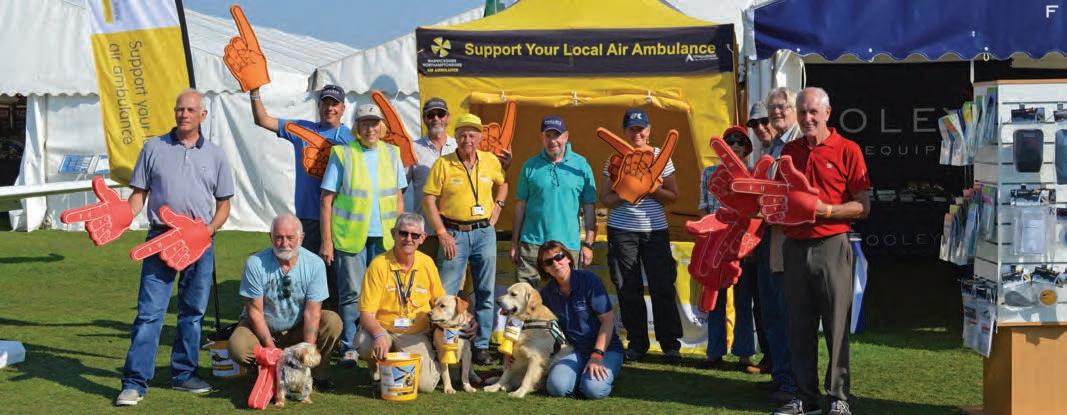
50th birthday was celebrated with cake for all. Please get in touch with your local Strut (contact details on the Strut calendar page) if you would like to find out more about how you can get involved.
We were also reminded that copies of the LAA’s booklet for 7–11-year-olds, An Airfield Adventure, has been sent out to all the Struts for use during fly-ins and gatherings with the aim of encouraging young people to have a close look at the airfield they are visiting. If you can use these booklets at any of the venues you plan to visit, please contact your local Strut or email office@laa.uk.co.
At this time some Struts are continuing their monthly meetings using Zoom and you are welcome to contact any Strut should you be interested in the advertised talk or to find out if fly-ins, fly-outs or BBQ’s have been arranged.
Andover Strut: Spitfire Club, Popham Airfield, SO21 3BD. 1930. Contact keith.picton@ntlworld.com
Bristol Strut: BAWA Club, Filton. 1930. Contact: chairman@bristolstrut.uk www bristolstrut.uk
1 June – Zoom. Aeronautical Research at RAE Bedford by Barry Tomlinson.
Cornwall Strut: The Clubhouse, Bodmin Airfield. Contact: Pete White pete@aeronca.co.uk 01752 406660 5 July - LAA Tour of England. The tour will call into Bodmin Airfield on Monday and use it as a night stop.
Devon Strut: The Exeter Court Hotel, Kennford, Exeter. 1930. Contact: david.millin@sea-sea.com 26 June - Terry Case Memorial Fly-In at Farway Common. 17 July - Branscombe, Devon Strut fly-in.
East of Scotland Strut: Harrow Hotel, Dalkeith. 2000. Contact: inrgibson001@btinternet.com 0131 339 2351.
East Midlands Strut: Please contact: tonyrazzell2@gmail.com 14 June – (Zoom) AGM, plus a Strut discussion on the implications of the recent CAA 2021/2022 Change Programme. We also have a Facebook group and upload recordings of some meetings where we have speakers.
Gloster Strut: The Victory Club, Lypiatt Road, Cheltenham, GL50 2SY. Contact: harry.hopkins@talktalk.net
We look forward to seeing you at the events organised for the summer and especially those which will be celebrating the LAA’s 75th birthday.
On behalf of the Struts, I would like to extend a vote of thanks to those who have been working away throughout the last year to produce regular Strut Newsletters, and to all who have mastered the art of arranging and hosting the Zoom meetings that so many of us have enjoyed. You have all helped to keep us informed and engaged, and many have made new friends across the airwaves.
Highlands & Islands: Highland Aviation, Inverness Airport. Contact: b.w.spence@btinternet.com 01381 620535. 19/20 June – Easter Airfield Fly-In (provisional dates).
Kent Strut: Cobtree Manor Golf Club, Maidstone, Kent. 2000 (Currently Zoom). Contact: Steve Hoskins hoskinsltd@outlook.com 07768 984507. 11 July – Kent Strut Fly-in at Headcorn, half-price landing.
LiNSY Trent Valley Strut: Trent Valley Gliding Club, Kirton Lindsey. pilotbarry1951@gmail. com http://linsystrut.wixsite.com/website
North East Strut: Fishburn Airfield. Brunch. Third Sunday of each month. 1130-1330 at Fishburn Aviator Café. Contact: alannixon297@btinternet.com
North Western Strut: Veterans Lounge, Barton, Manchester, 1930 for 2000. Contact: cliffmort@btinternet.com 07813 497427.
North Wales Strut: Caernarfon Airport, Dinas Dinlle. HEMS Bistro Café 1300. Contact: Gareth Roberts gtrwales@gmail.com 07876 483414.
Oxford Group: New Venue TBC. Second Wednesday each month. Contact LAAOxford@gmail.com www.oxfordlaa.co.uk
Redhill Strut: The Dog and Duck, Outwood, Surrey, RH1 5QU. Third Tuesday of each month at 1930. Contact: david@milstead.me.uk
Shobdon Strut: Hotspur Café, Shobdon Airfield, Hereford HR6 9NR. 1930. Meetings (once lockdown completed) second Thursday of month. Contact: Keith Taylor bushebiggles@sky.com
Southern Strut: The Swiss Cottage, Shoreham-by-Sea. 2000. Normal meetings will resume on the first Wednesday of the month when permitted. Contact palmersfarm@sky.com
Strathtay Strut: Scottish Aero Club, Perth Airport, Scone. Scone Clubhouse. Contact: keith.boardman@peopleserve.co.uk 07785 244146.
Suffolk Coastal Strut: Crowfield Airfield Clubhouse. 1900. Contact: Martyn Steggalls events@suffolkcoastalstrut.org.uk 07790 925142.
23 June – Strut BBQ at Monewden Airfield –food served from 1930 10 July – Boxted Fly-in. Details/PPR at www.flytoboxted.co.uk
Vale of York Strut: Chocks Away Café, Rufforth East Airfield. Contact: Chris Holliday 07860 787801 valeofyorkstrutlaa@gmail.com www.valeofyorkstrutlaa.wordpress.com 4/5/6 June – Fly out to Old Warden/Duxford/ Cromer.
19/20 June – Longest day World Tour of Yorkshire, BBQ and camp at Eddsfield. 31July/1 August – Yorkshire weekend at Rufforth East Airfield.
Wessex Strut: Henstridge Airfield Clubhouse. Contact neil.wilson@laa.uk.com 4 July – Wessex Strut fly-in which is also a Meet the LAA Day.
West Midlands Strut: Navigator Café, Halfpenny Green Aerodrome 1930. Contact: Graham Wiley westmidlandslaastrut@ googlegroups.com Stuart Darby stuartdarby134@hotmail.com. or visit our website wmstrut.co.uk
West of Scotland Strut: Bowfield Country Club, Howwood, PA9 1DZ. 19.00. Contact: Neil Geddes barnbethnkg@gmail.com 01505 612493.
Youth & Education Support (YES) – Contact: Graham Wiley gw20home@outlook.com
NB: Thank you to all Struts and clubs for getting in touch. If you have any stories, items you wish to share or updates for the calendar, please feel free to contact me at struts@laa.uk.com

Harry Leefe recalls his 2002 flight by Jodel from Croatia’s Dubrovnik to Mostar in Bosnia & Herzegovina, the first private flight since the start of the Bosnian war in 1992…
As I contemplate the sale of my beautiful Jodel DR100A, built in 1958 and owned for 31 years, to a French flying club in Normandy, I am thinking of the fun I have had with it over the years flying in Bosnia, Corsica, Croatia, France, Italy, Switzerland and the UK.
G-BTHH was purchased by me and a flying partner in Blackpool in 1990 from Ernie Horsfall, who to this day remains well known in general aviation in the UK and France. As you will read in this issue (page 18), he recently celebrated his 103rd birthday. At the time of this adventure in 2002, it was still on the British register, but in the latter years of my ownership went back onto the French register as F-HCHH.
With Ernie flying in the left-hand seat, we moved the
Above Harry Leefe, Sandrine Peillon and John Leefe at Mostar Airport, 9 September 2002
Jodel to Bourg en Bresse (LFHS) in 1993, when I joined the United Nations High Commissioner for Refugees (UNHCR) in Geneva. Bourg is 109 kilometres from my home in Switzerland and is much cheaper as an operational base than Geneva – and other airfields closer to home.
I subsequently served UNHCR for 25 years, retiring in 2018 after many postings, emergency missions and adventures in support of refugee and Internally Displaced Persons operations. Suffice to say, I kept the Jodel at Bourg en Bresse even though I was working overseas and travelling a great deal.
It was not easy keeping the aircraft and maintaining my flying proficiency and licence, however with some very good friends in France, Switzerland and the UK, and the assistance of various maintenance units, I managed somehow to keep flying.
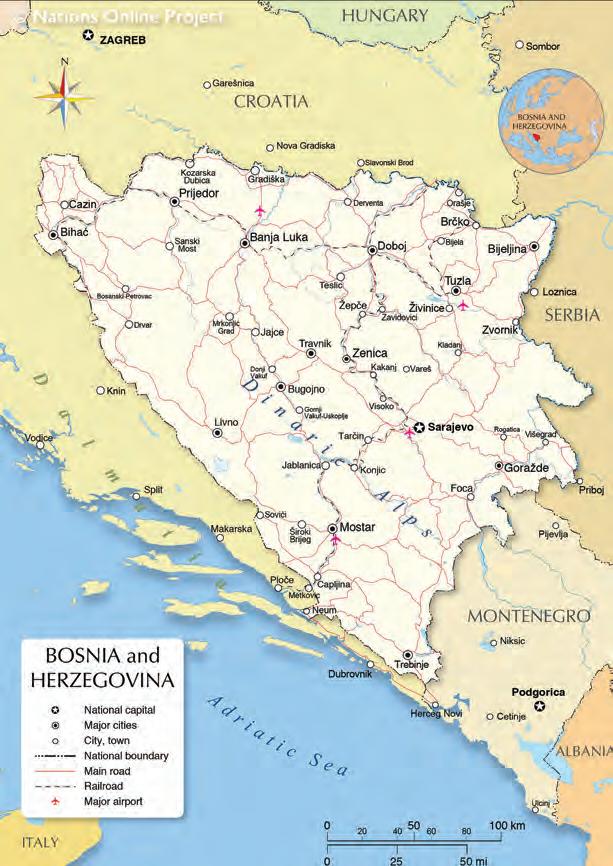
In 2002, while posted to Mostar BiH as Head of the Sub Office (South East BiH), I flew it with a Swiss pilot friend to Dubrovnik, where it was based for three months so I could fly it at weekends. This allowed some fantastic flying with family and friends over the islands of Croatia, with landings at Brac, Split, Pula, and Zadar. There were not many airfields available at that time in Croatia.
Within UNHCR Mostar office, there was a certain amount of enthusiasm to fly with me, as almost all of the staff had never been in a light aircraft because of the regulations governing the former Yugoslavia preventing private flying; and then the subsequent NATO Controlled Airspace imposed during the Bosnian war 1992-1995, and the Kosovo war 1999.
As Head of UNHCR Sub Office Mostar (HSO) I had daily contact with the Commanding Officer of the NATO Stabilisation Forces (SFOR) for the region, a French General headquartered at Mostar Airport.
As his civilian counterpart under the Dayton Peace Agreement, my UNHCR team and I had a very good working relationship with the French, Spanish, and Moroccan forces operating in the region. It was because of this relationship that he gave permission for me to fly my aircraft to Mostar, subject to NATO approval for flying into the NATO Controlled Airspace.
It was also in the interest of SFOR and the civilian aviation authorities to encourage commercial and private flying into BiH as part of the post-war economic recovery
plan. My request for the flight was seen in that context, as Mostar Airport wanted to open up to commercial and private flights and generate revenue.
Fortunately, prior to my promotion to HSO, I had been the UNHCR Senior Military Liaison Officer to NATO/SFOR based in Sarajevo for two years (1998-2000), so my contacts in NATO/SFOR from this period gave me access to the regulations governing flying in the region.
Regulations for A/C Operating as General Air Traffic (GAT) in the Balkan Joint Operation Area (JOA) Version 3.0 (dated 30 July 02), was issued by Combined Air Operations Centre 5 Airlift Liaison Element based at Vincenzo airbase, Naples, Italy and consisted of 32 pages. The authority for the regulations were covered under the United Nations Security Council Resolution 1244; Military Technical Agreement between the signing parties (KFOR, Govts of Serbia & Montenegro); General Framework Agreement for Peace in BiH, and the Letter of Agreement between NATO/SFOR Airspace Control Authority and Croatia Control Ltd. Zagreb ACC.
As you can see, it was not so simple to fly an aircraft into Mostar from Dubrovnik Croatia in 2002! It took five days to get the various permissions and a time slot for the flight into Mostar, and I had to fill out: Flight request to NATO, Form 8A; Annex B NATO Release of Liability and Indemnification Agreement (ROL); Annex E BIH APOD Slot request form (Aerial Port of Debarkation); receive a decision from COMAIRSOUTH approving the flight; and receive APPROVAL from BiH Department of Civil Aviation for the flight with a slot time into Mostar.
Above The route from Dubrovnik to Mostar.
Below The Dinaric Alps, which follow the coast for 400 miles from Italy in the north-west to Albania in the south-east and rise to 8,839ft.
G-BTHH was designated a United Nations Flight (which was unexpected) and under the control of NATO Zagreb. A flight plan was sent to Sarajevo and Mostar Airport and times were strictly adhered to. On the day of the flight, 9 September 2002, my brother John (a member of Leicester Aero Club), Sandrine Peillon a French UNHCR colleague, and I drove from Mostar to Dubrovnik, checked out the aircraft, and filed the flight plan. This caused some consternation as it was the first private flight since the war in Bosnia to be going from Dubrovnik into Bosnia. The flight office asked me how I was going to get to Mostar, to which I replied, “Take off, fly down the coast to Ploče, turn right and follow the river Neretva until Mostar and land!”
The flight itself took 55 minutes, chock to chock, and on arrival we were met by the General’s ADC. I was taken off for a meeting with the General as there were some issues
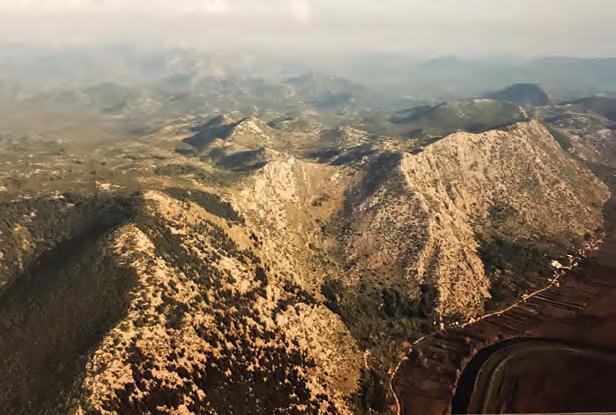
between UNHCR and SFOR he was not happy about. My brother and Sandrine enjoyed the hospitality of the French Armée de l’Air while I was in the hot seat!
Two days later, with another UNHCR colleague (a Belgian national) John and I took off back to Dubrovnik. It was a very hot day with no wind, and even though the Mostar runway is long, it took some time to gain height and there are some rather large hills at one end. We gradually clawed our way skyward but were getting rather close to the hills and John commented ‘we might not make it!’. I looked behind at the UNHCR colleague and saw he was taking plenty of photographs and said, “At least the air accident investigation will have plenty of evidence of pilot stupidity!”
We cleared the hills, electric wires and pylons – not by a lot – and I saw a woman hanging out her washing looking rather perplexed at this low flying aircraft over her house.
Below The coastal region near the turning point at Ploče, where we turned inland towards Mostar.
Bottom Following the River Neretva to Mostar, which is just behind the mountain in the foreground.
The flight after that was uneventful and we landed in Dubrovnik Airport 52 minutes later and gave a debrief to the Dubrovnik ATC. The authorities opened up an immigration and passport hall for the three of us and asked where we had come from. We replied, “The 10.30 from Mostar.” He said there wasn’t such a flight and where was our aircraft. Having pointed out the Jodel in the private aircraft park he told us to ‘bu**er off’, and sent us out through a side door with no formal entrance back into Croatia.
A week later I flew it back to the UK over three days via Slovenia, Austria, Germany, and France to Akki Aviation at Turweston, where it was subsequently rebuilt, as there was some rot in the airframe.
Fun times and very happy memories of which there are many concerning F-HCHH, which makes the sale after so many years of ownership, a bitter-sweet moment. ■



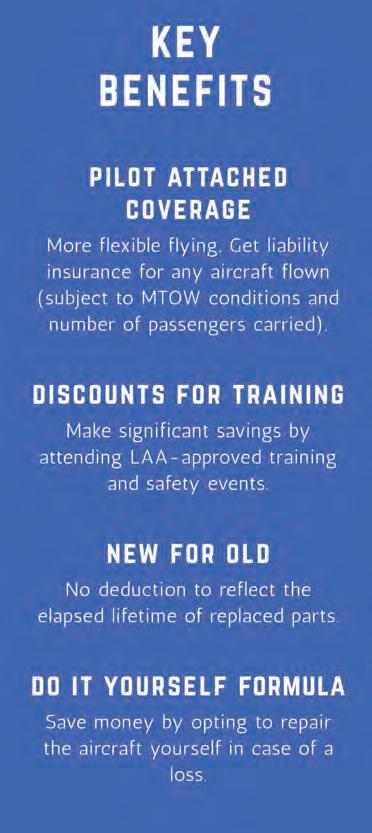




While it’s been pretty wet recently, we hope you’ve been able to enjoy some recent flying. For July, we are delighted to bring you another four FREE landings, this time for Breighton in Yorkshire, Enstone in Oxfordshire (North side grass only), North Coates in Lincolnshire (weekends only) and Strathaven in South Lanarkshire, Scotland.
Free landing July 2021
Vouchers are for light single-piston engined aircraft only. Although the Covid restrictions continue to improve, it makes sense to call the airfield, even if they are not PPR, to ensure they and any facilities you may need are fully operational. Please take the voucher with you, not a photocopy, and have a great day out.
Breighton Aerodrome 01757-289065
Breighton is located 5.5 miles north east of Selby and is home to The Real Aeroplane Company, which has a great collection of historic aircraft on the airfield. Please PPR – non radio aircraft welcome – circuit to the south at 700ft QFE and join live side as there is often aerobatic activity which takes place on the north side of the runway centreline. No overhead joins. Grass runway. Avgas and JET A1 fuel on site – self-service. Restaurant on site. Radio:129.805 https://www.realaero.com
Free landing July 2021 North side grass only
Enstone Flying Club 01608 678204
Situated in the middle of England, Enstone is set in very pleasant countryside. This voucher is offered by the Enstone Flying Club, please use north side grass only not the main hard runway. The club has an area in which to sit and relax. Avgas available. No straight in approaches, join overhead. Circuit 800ft for standard aircraft, and 600ft for microlights. Talk to Oxford or Brize Norton who are both helpful. Avoid overflying local villages. Radio: 129.880.www.enstoneflyingclub.co.uk
Free landing July 2021 WEEKENDS ONLY
North Coates 01472 388850
Based on a former RAF Airfield, the North Coates Flying Club welcomes all private pilots and aviation enthusiasts. Situated 6nm south-east of Grimsby, the airfield is right next door to the Donna Nook Firing Range, so please only visit at the weekend. PPR by phone. Avgas at weekends. The restaurant offers drinks and snacks. A nice little museum tells the airfield’s story. A/G Radio: 120.155 www.northcoatesflyingclub.co.uk
Free landing July 2021
Strathaven Airfield 07979-971301
Strathaven is set in beautiful countryside and although predominantly a microlight airfield, if you are on a day trip or touring Scotland, you are welcome to drop in and say hello. Located near East Kilbride, there are many places of interest to visit nearby. If you need to organise a taxi, please phone ahead, as you may have a long wait otherwise. No fuel available. Please PPR by phone on your first visit. All circuits to the North please. Safety Com: 135.475 www.strathavenairfield.co.uk




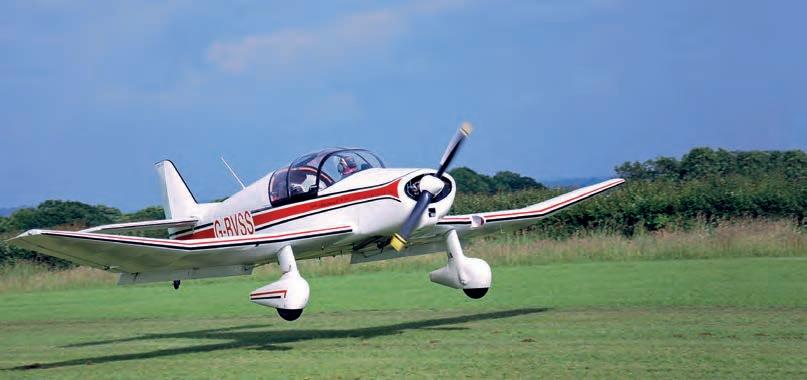
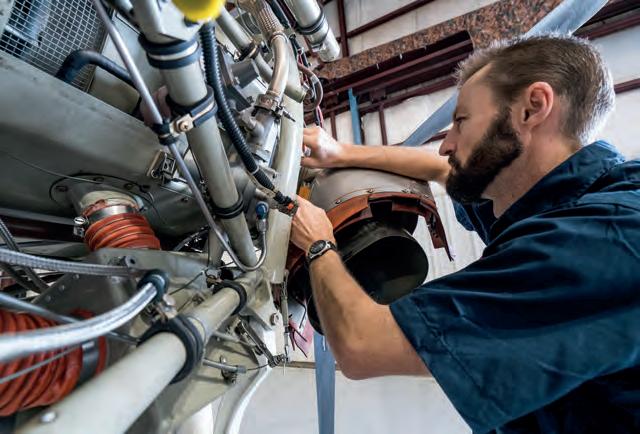
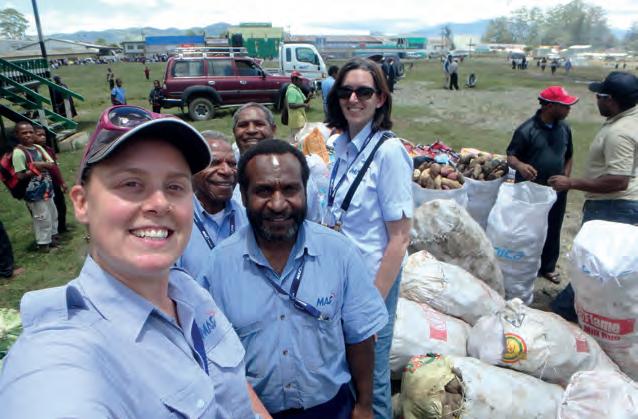





Remember that wonderful afternoon and evening LAA members spent at the Shuttleworth Collection back in that last pre-Covid summer of 2019? Well, we’ve been invited back again this year, to help celebrate our 75th Anniversary at the LAA ‘Flying For Fun’ evening air show at Old Warden aerodrome near Sandy in Bedfordshire, which runs from 6pm till just before sunset on Saturday 17 July.
We have a special relationship with Shuttleworth; many of the Collection’s aircraft, including their unique 100-plus-year-old ‘Edwardian’ fleet, World War One types and the glorious DH88 Comet operate on LAA Permits to Fly. They are therefore inviting LAA members to attend either by road or by air, with specially discounted ticket prices and dedicated LAA members’ parking areas (for cars or aircraft), as well as a special static display of invited LAA types.
To maximise safety against infection, the Shuttleworth Collection is using its “Drive-In Airshow” to ensure a Covid-safe environment. Visitors by road will each be parked in a 5m x 5m box where you will have enough room for your car and to set up your picnic alongside. Catering and refreshments will be available to purchase in your drive-in zone. Each zone will also have toilet facilities, including disabled toilets and baby changing facilities. You will be free (and encouraged) to explore the Shuttleworth site including the Swiss Garden, hangars and of course the ‘LAA Aircraft Uncovered’ static display, before returning to your car spaces to enjoy the air display by a plethora of historic aircraft, with commentary available via FM radio.
The ‘LAA Aircraft Uncovered’ will feature a selection of LAA types covering our 75 years and be on display from around 1pm until 4pm. We’ve contacted a number of members who will field a selection of aircraft representing our fleet, each owner being available to chat about their pride and joy in the unique Shuttleworth pre-show ‘meet the pilots’ show and tell.
If you’ve never been to a Shuttleworth evening air show, it’s a must. A unique curving display line allows the aircraft to be displayed at their best angles against the rural Bedfordshire setting, and will include both the Collection’s own aircraft and visiting LAA aircraft, both ancient and modern. The planned flying display will include a special Pitts duo, Van’s RV aerobatics, Great

War Display Team, Calidus gyroplane, an electrically powered E-paramotor, as well as the Shuttleworth Spitfire and Sea Hurricane, DH88 Comet and Mew Gull racers.
evening.
Photo: Wikipedia.
But what really sets the Evening Airshows apart are when, as the sun sets, subject to suitably calm conditions their famous fleet of ‘Edwardians’ takes to the air. It is the only place in the world where you can see aircraft such as the 1911 Avro Triplane and Bristol Boxkite replicas in the air, hopefully being joined by the Collection’s original 1910 Blackburn and 1909 Bleriot XI. The latter is the world’s oldest airworthy flying aeroplane.
We have arranged a special advance ticket price for LAA members and special arrangements will apply to members wishing to fly in ahead of the display. You can either depart via a mid-evening take-off-slot or if you wish, stay-over, camping beside your aircraft. For further information and to book drive-in parking spaces and tickets, please contact the Shuttleworth Collection www.shuttleworth.org/events/flyingforfun/
If you are flying in, we are planning to make some further special arrangements. Please contact us at office@laa.uk.com in the first instance and we will give you further information as we have it. ■


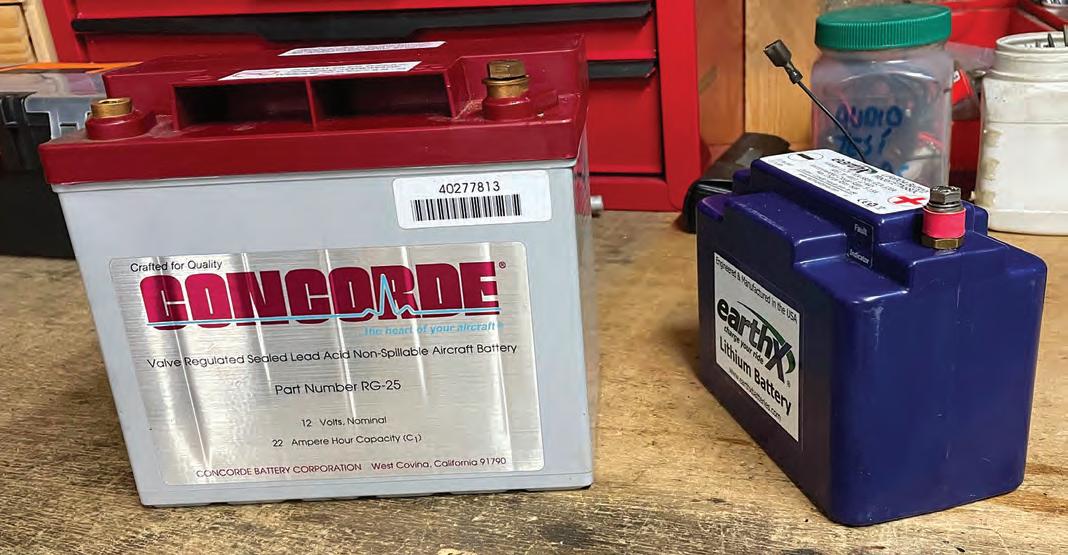
Ian
Fraser explains how to check and look after your battery, and what to consider when deciding to replace leadacid with lithium…
Batteries are one of those components that many of us take for granted and most of us are totally reliant upon them for starting our aircraft. But how do we know if they are up to the job?
Manufacturers suggest life expectancy of a normal aircraft battery could be five to seven years, and although some users wait until the starter begins to falter before replacing the battery, others change them regularly as a matter of normal service routine.
Some of us now permanently connect smart chargers, which the ‘charger’s champions’ say can double the life of a battery. I have heard reports of aircraft battery lives of between two and 20 years, but who really knows how long you can expect your battery to be reliable for? I don’t think anyone does. So, is there a practical, simple engineering means of deciding if and when your battery needs replacing? The short answer to that is, yes.
However, if we do decide the battery needs to be replaced, do we really need another 12kg lead brick? That’s a fair chunk out of our useful load after all, and technology has improved such that a much smaller lithium battery can provide adequate current to start even a large engine. With the reducing electrical load for other electrical equipment, suitable batteries are
available today that weigh less than 20% of the original, which could be a saving of 10kg.
Before we look at smaller, lighter batteries it is key to appreciate exactly what an aircraft battery needs to do and with how much power it needs to do it – and that is it must not only start the engine, it must also provide an adequate source of electricity in the event of an alternator failure.
To explain starting and its battery requirements, I will split the process into two parts: getting the starter itself and the engine moving; and then the normal cranking of the engine.
Getting the starter and engine moving, or ‘breakaway’ as the specialists refer to it, initially requires a massive burst of current, e.g., for a Lycoming O-320 some 200-300 amps. This current then reduces as the starter gets up to speed. Once it is moving at the normal turning or cranking speed (about 60 engine rpm or two blades per second), that current should drop to between 80-120 amps. If the engine is labouring during the starting process due to cold weather or a fault, it never gets to that sweet cranking speed and is actually placing a higher demand on the battery than if it were cranking normally.
The ability of a battery to provide these high currents is known as it’s Pulse Crank Amps (PCA) or peak power rating, and for the cranking phase Cold Cranking Amps (CCA) or 15 second power rating. While it is possible to measure the battery’s ability to deliver these currents with a battery test set or ammeter, it’s expensive and messy and there is a much easier way to do it.
An ‘off-load’ lead acid battery’s fully charged voltage is about 12.5v. But the voltage measured while delivering high currents is a good indicator of its health. Its own internal resistance will result in a drop of a volt or so between the battery terminals when under cranking load, but on its own this is not unhealthy. If, however, during starting (from fully charged) the voltage drops below, say 10v, or panel lights noticeably dim, it indicates a potential battery problem.
But the key to effective starter cranking is the voltage at the starter. For my RV’s starter, (a B&C), it recommends a minimum voltage of 9v while cranking, so that is where we should actually measure it. Why would the voltage at the battery and starter be different? Poor or loose terminals (including engine earthing), dirty solenoids or even under specified cable (too long and/or thin) can impact the voltage that gets to the starter. This reduces starter efficiency, but such problems are often misdiagnosed as battery faults.
My RV has four feet of 4 AWG (heavy duty) cable from the battery to the starter and back, including ground cables. That’s short by many aircraft’s standards but alone accounts for ¼ volt drop at cranking currents due to its resistance, even if everything else is working perfectly. Longer or thin cables equate to more resistance and less volts (Ohm’s law). If the battery itself is OK (greater than 10v while cranking) but the engine cranks too slowly, then that is your next port of call.
So, you can quite easily check your battery’s adequacy to start the aircraft by measuring the voltage at the starter, but for how long or how many times will it do it?
Below The set up to carry out a capacity test on your battery.
Bottom Check the voltage drop at the starter motor.
The second health consideration is storage capacity, amp / hours, which is important for both starting and electrical back-up. Remaining charge or capacity (what it actually has left, not what is written on the side) is important to the battery’s long-term effectiveness. As you use a battery (without a charger or alternator) its voltage gradually reduces until it comes to a point where it no longer has enough voltage for the devices it is supplying (typically between 8-10v, see device manuals). It is measured by the time it takes the battery voltage to drop from a fully charged 12.5v to 10v while supplying a known current. Over time, due to use, lack of use, or indeed misuse, the number of amp / hours a fully charged battery can supply decreases, and eventually no amount of charging (by any means) will sustain its capacity.
To determine the remaining capacity there is a simple test. From when fully charged, drain the battery with a test load until it reaches 10v, measure the time to do that and you can calculate the amp hours used. I use a 55W (4.5amps) car headlamp as my load (it is representative of my RV’s essential equipment load). When new, I would expect my Concorde 22AH RG25 battery to last for just under five hours (22/4.5). However, if its capacity has deteriorated, it will take significantly less than that. At four hours it is time to consider a change.
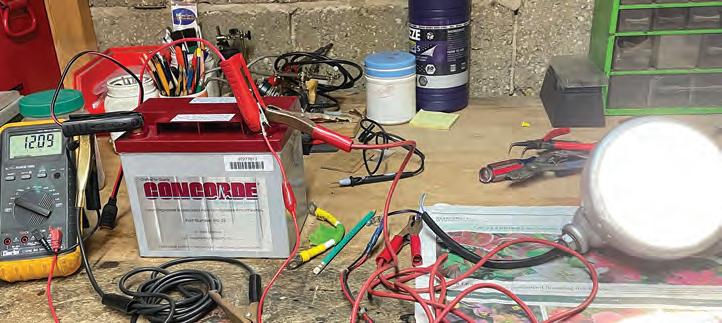

The Concorde (lead acid battery) maintenance schedule says that if it fails the above test with less than 19-amp hours, before you condemn it, give it a conditioning charge and test it again, it may recover. Some smart chargers have a conditioning charge mode to do just this.
Battery capacity deteriorates with age and lack of use, which is mostly why they die, but at what point does it become a liability or safety risk? The normal criteria is to change it when it drops to less than 80% of its original storage capacity – the rationale behind that is not the actual 80%, but below 80% the deterioration accelerates, and in less than a year’s time your battery could let you down.
Lead acid batteries also self-discharge, even if not connected. If not recharged regularly through use or maintenance, they eventually flatten themselves to a level that permanently damages them and their capacity. A regular charger is fine to recharge a battery but, once charged, leaving it connected can do more harm than good.
Many of us now use ‘smart’ battery chargers (e.g. CTEC / Optima) on our aircraft to overcome this. They charge the battery as normal, but once they detect that it is charged, revert to the so-called ‘float’ mode, which preserves the battery and charge, supposedly without damage.
While these devices definitely pay for themselves in extended battery life and with prompt, reliable starting, they can also mask impending failure until it is potentially serious. With a smart charger, the battery is always topped up so a defective battery with say, only 20% capacity left, could still achieve a good burst of cranking, and thus comfortably start an aircraft, before suddenly giving up the ghost. You may never spot this while the alternator is working until it fails completely during a backup or restart role (e.g. for the return flight). I have seen this happen on my classic vehicles. The worn-out ‘float charged’ battery starts the engine easily – once – but after that I have experienced them neither accepting nor holding a normal charge and not even running the lights. The battery was dead and had no indication that it had a problem! So, if you are using a smart / float charger,
Below A smart charger is a good idea for lead-acid but can also mask problems.
checking battery capacity routinely is doubly important for your safety.
With nothing more than a voltmeter, watch and headlight bulb, you can determine the health of your battery and starter system and take the guesswork and speculation out of the equation.
During this year’s annual inspection, lockdown restrictions prompted me to look carefully at alternatives for my RV-6’s battery. Measurements of my 12-year-old Concorde RG25 showed that, while within spec, it was close to the 80% capacity point, so I decided to make the change to lithium.
Lithium battery technology was discovered in the US in 1980 and the first practical lithium batteries were developed by the Japanese in 1985 for phones and handheld computers.
The technology, known as lithium ion, supersedes several old technologies, including the heavy lead-acid batteries we use in aircraft. It achieves a power (storage capacity) to weight reduction over the then current technologies of some 60-70%, plus there are other electrical characteristics that make its stored electricity more usable. Unfortunately, the electrolyte they originally used allowed internal short circuits to develop, resulting in some disastrous fires. Subsequently, better chemistry has evolved with lithium iron phosphate (LiFePO) now being dominant, offering a much safer solution. However, there is still a lot of energy stored in a small volume and out of control loads or internal faults could result in overheating. This is now managed by built-in electronics and is the safe lithium battery technology today, a complex but reliable package of chemistry and electronics.
Small lithium batteries can now provide enough current to start quite large engines and several have been developed for motor racing. It was only a matter of time before those batteries came to the attention of aircraft homebuilders.
Lithium batteries have several quite different characteristics to those of lead acid and the LAA, having considered the safety implications, now has a (no fee) Standard Modification, SM14337 in place for upgrading your aircraft battery. Read it carefully as it contains a number of constraints and requirements which you must consider in your upgrade.



In its document, the LAA also published a list of acceptable lithium iron batteries, but be careful here, all they are ‘approving’ is the safety of carriage and connection of the battery in your aircraft, not saying it is either suitable or fit for purpose, that is your call. The modification must be approved by your Inspector before you fly, so it is best to get him / her involved from the beginning. I chose an EarthX ETX680C for my RV, for reasons discussed later. Could lithium be an option for your aircraft?
The key considerations…
First and foremost, weight and balance. One of the requirements of the Standard Mod is to use the original mounting position. If the original battery was close to the C of G, as on the RV-6, then the 10kg or
so weight reduction will not move it far and it shouldn’t exceed any limits. But if, for example, you have an RV-8 where the battery is some distance from the C of G, it may move it out of limits for some load cases. As part of the standard mod, you must demonstrate that it is still within acceptable limits. If you need to move the battery, it becomes slightly more complex – you can, but you must go through the full LAA modification approval process.
The next, and key question, is will it start your aircraft? To select the battery, you can of course calculate or measure the demands of the starter, but
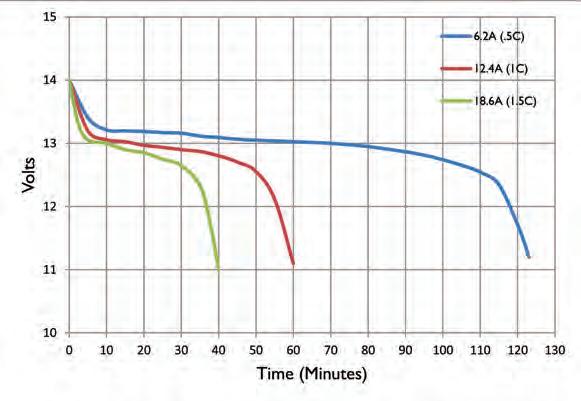
it’s much easier to match or better the peak and cranking capability of your current battery. As a general rule of thumb, a lithium battery with just 30% of the capacity of a lead acid one will provide the same cranking power. My 0-320 was not a problem for any of the candidate batteries.
Then you need to consider capacity or amp-hours (ah). The graph shows the capacity of the EarthX lithium 12ah battery. From full charge, its output is reasonably constant, delivering 13v at six amps for two hours, 12a for one etc. It can even deliver high cranking current (100 amps or more) for much more of its capacity cycle than a lead acid battery, providing many more starts than you might expect. This is sometimes referred to in adverts as a ‘lead acid equivalence’.
Don’t be misled, it works for starting, but the same capacity oddity is not true for the alternator failure back-up function. That must be calculated properly and planned for. An important aspect of lithium batteries to be aware of is that when they run out of charge, they do so suddenly. No warning and no more electrical power! Your calculations must consider that.
Alternator back-up is about continuing to run your essential electrical and electronic equipment in the event of an alternator failure. The LAA talk about 30
Below An electrical load sheet for the RV’s electrical requirements.

minutes and ‘load shedding’ to achieve it. I believe 30 minutes is far too little for touring. If your alternator fails, you need to get somewhere with reasonable accommodation and a chance of fixing it, not just the nearest airfield. Load shedding is a method for reducing the electrical and electronics functions in use to those essential to complete the flight safely, e.g. flight and engine instruments, Comm, perhaps Intercom and Nav but, no lights, music, autopilot, Comm Box 2, transponder, or USB devices etc. The electrical load page from my RV-6 handbook shows the plan by highlighting in colour the criticality of the functions. It is based on average, not peak consumption, as that is what happens in real life.
The minimum essential equipment requires 2-2.5 amps. To complete a typical touring flight of three hours, I need about 7.5 amp / hours of power. I added enough for a couple of engine starts, (250a/10 secs) plus a bit for flaps and fuel pump and the total to complete a flight under load-shed conditions is about 8.5ah.
Bearing in mind battery lifetime capacity degradation (-20%) the smaller candidate batteries available would be pushing my luck but a 12ah EarthX battery gives me enough margin to complete a touring flight comfortably. It is important to document the load shedding plan where it can be accessed in an emergency.
Once you have selected a suitable battery you have several electrical and mechanical considerations. Probably the most significant of these is over-voltage protection, something we should all have (do we?). Over-voltage is an electrical problem that can occur if the alternator’s field winding or regulator fails and the alternator outputs a much higher voltage (greater than 15v) than some of the aircraft’s electronics are designed to tolerate. Uncontrolled, it could damage your avionics and instruments and thus your wallet. In the normal world this might be called a ‘surge’, and reports of it in aircraft are surprisingly common.
Over-voltage can happen regardless of your battery type but all lithium battery manufacturers concur that lithium cells can be damaged by exposure to over-voltage, hence concern about over-voltage protection (OVP). Surprisingly, many aircraft don’t have OVP, but most that do use a system called a ‘crowbar’ to provide it. This device, sometimes part of the regulator, sometimes separate, works in conjunction with a circuit breaker in the alternator field (charge enable) line. If the crowbar (a bit of electronics) detects over-voltage, it simply connects the alternator field wire to ground, and the alternator field circuit breaker should be tripped. A relic of the Jurassic period of aviation, there should be many better ways of doing it today, but there doesn’t seem to be.
Disconnecting the field should automatically disable the alternator and you are safe to continue with your flight on battery power. Those of you who have attended the LAA electrical course may recall Nick’s fascinating demonstration of just how fickle circuit breakers can be and there are several searching questions to answer on the subject of OVP, but they are beyond the scope of this article.
The aircraft voltage being in normal range is an
important flight safety parameter and, to ensure that you know, the LAA insist that you have a voltmeter visible to the pilot, and also the ability to fully isolate the alternator field and output. In my case, my charging circuitry was already compliant and most of my devices are OK up to 33v anyway (I already fried those that weren’t with an earlier unprotected alternator over-voltage fault). If you don’t have OVP and a voltmeter, then you may have some thinking, wiring and other changes to do.
One of the points in favour of the EarthX battery is that it seems to be more sophisticated than the rest in terms of its built-in battery management system (BMS). The BMS monitors many aspects of battery performance and manages, reports (via a status indicator) or safeguards both you and the battery. In the case of an over-voltage condition, it blocks charging, protecting the battery regardless of the effectiveness of the crowbar. It also manages cell balance, an important battery life thing and, if you manage to discharge the battery, it switches it off before any permanent damage can be done. Whether that is a benefit or an overcomplication remains to be seen, but to me it seems a clever and useful system.
Another reason for choosing EarthX was that its physical size fitted my existing carrier quite well. The LAA document implies that you can use packing to locate the new battery, but I would be very cautious in doing so. For their small size, lithium batteries can produce a lot of heat, and wrapping them in packing will not help cooling.
The installation in the RV-6 was quite simple. The carrier for the existing battery unbolts and can be removed for modification. I just added the battery manufacturer’s standard ventilated mounting bracket
Below It’s worth installing an easy access charge / monitoring point for whatever battery type you have installed.
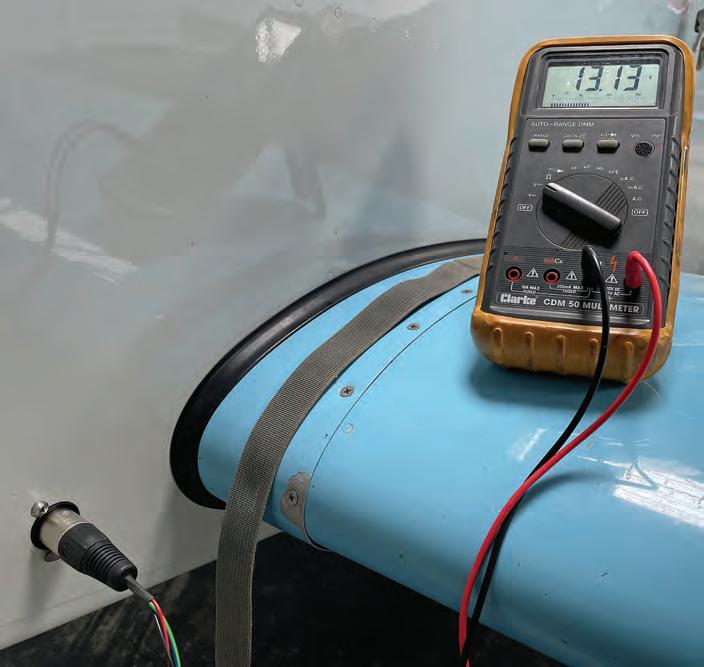
to the carrier and left off the original battery cover (for cooling). One cable needed replacing to do a neat job and the terminals must be covered with insulating sleeves. An EarthX battery has a fault indicator light connection, so this was added to the panel and wired in.
While in the battery area, it is worthwhile considering adding a socket to the exterior of the aircraft to charge and monitor the battery. Mine connects to the battery positive terminal via a (7amp) fuse and to the starter terminal so I can make all the measurements described earlier.
Pre-flight, in-flight checks and continued airworthiness
The essential thing is to know and monitor the important voltages. Adequately charged, but offcharge you should see greater than 13v on your voltmeter, if it is below 12.6v it is too flat and could quit imminently (see the graph). During flight, charging should be between 14 and 14.4v*. More and it is over-voltage, less and it may not be charging effectively. Although in an emergency, any charger will charge one, lead acid chargers can damage the battery. Optimal charging requires a specialist Lithium battery charger which deals with their foibles so for long and reliable battery life, it is better to use one of those.
Lead acid batteries can self-discharge by up to 30% capacity per month, hence they benefit from a top up with a float charger. Lithium batteries normally discharge at 3% or less per month so float charging is much less important. In fact, rather than benefit the battery, it seems that the specialist chargers just ‘do no harm’ if left connected. If you do let your battery go flat, the BMS may switch it off to protect it from itself. And the catch here is that some lithium batteries, once they have switched off, don’t naturally restart or take a charge, they need to be ‘bump started’ to recover them. The latest smart chargers have a button to do this. See the battery or charger manual.
Of the batteries available on the LAA’s list that I could find out enough about, the EarthX seemed to be the one most specifically aimed at the aviation market, and after carefully comparing the essential parameters, it was the one I chose. Installation in my RV-6 only really took a day’s work, and it has performed perfectly since. Multiple starting has been fine, and the battery voltage has stayed at the expected level without float charging. The weight change has made no discernable difference to empty flight characteristics. As with much of this ‘invisible’ equipment, the issues by which it may really be judged (reliability) hopefully may never occur, and so far, so good. I will open a thread in Hangar Chat so if anyone has any experiences, they would like to share, please do it there.
* Check all these values for your specific battery. Note: I have been deliberately vague about some values because they are often unique to an individual set of components, and manufacturers data can also be inconsistent. The values I have suggested will put you in the right ballpark, but the best way is to measure and record the key values when everything is working. You then have an aircraft / equipment specific set of values to compare against later to judge battery health. ■

This month we meet Tim Taylor, former Navy pilot who moved on to airline and latterly corporate flying…
Welcome Tim, please tell us of your early days I was born in Redruth, Cornwall, but spent my childhood in the North West of England, predominantly in Warrington, surrounded by pits and manufacturing industries. My desire to go to university was somewhat opposed by my career’s teacher, who considered an apprenticeship at the car/paint/glass factory more appropriate. However, with a bunch of mediocre A-levels under my belt I went just down the road to Manchester University to study mechanical engineering.
While there I joined the University Air Squadron and proceeded to devote far too much time to this fantastic aviation and social environment, so a mediocre degree followed...
After a career as a pilot in the military, I left in 2003 to fly the A320 for a BA franchise, then moved over to Virgin Atlantic in 2007. This went south in 2009, so I took a temporary contract back with the Navy and from there moved into Corporate Aviation.
Since leaving the RN full-time, I’ve continued to fly with them part-time and have been lucky enough to have flown Sea Harriers, Hawks and Tutors in my time off from the day job! Fate has been a constant wingman and I frequently admit to having ‘never worked’, just enjoyed a ‘series of paid hobbies’!
March 2020 was probably not the best time to join a start-up company whose business model was to fly the rich and famous around Europe, but start it I did, and we have added another jet (both Challenger 605s) to our fleet, with hopefully more joining in the coming months.

My father insists that somewhere around the age of six, during a family camping holiday in Ullapool, we were ‘buzzed’ by a pair of F4 Phantoms at low level. Apparently, I turned to dad and said, “I want to do that!”. A literary diet of Biggles books, Commando magazines and Warlord comics led to joining the Air Cadets at age 13, three-quarters and one day – the minimum age! Gliding and AEFs in the ubiquitous Chippy followed, and my official introduction to flying training started on 4 February 1981.
The 635 Venture Gliding School at RAF Burtonwood, conveniently located a mile from my house and 400 yards from my school, became the new centre of my world. Most weekends and some school holidays would see me there driving Land Rovers and winches, sweeping hangars and cleaning gliders, plus getting free flying towards becoming a gliding instructor.
Needless to say, my education and studies suffered a little… but to this day I enjoy PFLs!
During lunch one day in the sixth form, I nipped over the fence onto the airfield, flew twice, drove the winch for half an hour, then nipped back in time for double physics.
In what, where and when was your first flight?
It was in G-ARLW, a Cessna 172 from Barton Aerodrome near Manchester, in October 1974, I think. Roger, a friend of my dad, flew my two brothers, dad and me, though not at the same time and we all became pilots – I guess he did something right.
After two years at the gliding school, I swapped my T21 Sedbergh’s, T31 Cadets and T61 Ventures for Bulldogs at the UAS. After four attempts I was accepted by the RAF for pilot training and flew the Jet Provost T3 and T5 before moving on to the Hawk for Fast Jet pilot training. My request to be a helicopter pilot fell on deaf ears… so aged 24 I was posted to fly the brand-new Tornado F3 fighter. Mach 2.2, 45,000ft, eight missiles, one gun and getting paid. What was not to like?!
Six years and three flying tours on the F3 raced by, then I was ‘specially selected’ (I never did find out what that meant) to serve with the Fleet Air Arm as an exchange pilot flying the then new Sea Harrier FRS2. My three-year tour ended up lasting eight years and included ‘jumping ship’ to the RN, having a family and buying a house. Twenty-five years later we’re still in Somerset, I’m still in the Navy (as a Reservist since 2003), though the


Top left Taking off from a carrier in a Sea Harrier.
Top right A young Tim with the Hawk, an aircraft he flew on and off for more than 30 years.
Above Tim carried out his jet training on the Jet Provost.
Sea Harrier has made way for Hawks and now Grob Tutors. I’m still getting paid to fly.
Of the jets I flew, I have the fondest memories of the Sea Harrier. Like most things difficult to do, they bring the greatest rewards. She was not an easy aircraft to fly, a whole new set of VSTOL skills had to be learned. She was demanding to operate as a fighting machine, developed on a shoestring with some dreadful system integration. And the runway moved between take-off and landing! But we were all immensely proud of our aircraft, squadron and our ship.
We ventured worldwide, took on all comers, and generally beat them. A true multi-role aircraft and probably the best value for money aircraft the FAA ever had. Of course, I may be biased...
I came to the Hunter pretty late in life, starting to fly them when I was almost 50 – until this year I was the last new Hunter pilot in Britain but have now been pipped to the post by an old friend. Ricko who’s 58! Well known as ‘last of the sports models’, the Hawker lineage (through to the Sea Harrier and Hawk) was evident. Again, beautiful but demanding to fly and operate, I’d love to start flying them again, but that is becoming ever less likely.
I flew the Hawk over a 30 year period, although with an 18 year gap in the middle. In that time literally nothing
had changed. Everything you need, and nothing you don’t (except maybe a RADALT). Logical systems, clear instruments, carefree handling and still looking good over 40 years after the first one flew – a great Hawker product. Despite having not been in one for nearly five years, I would happily jump back in and take one for a spin around the block.
With the RAF I did my frontline time at RAF Leeming and Coningsby. My RN time was always at Yeovilton, though I was lucky to serve on all three of the Invincible Class carriers.
My specialisation within the military flying was Air Warfare and Weapons. Early in my first tour at Leeming, I was ‘specially selected’ (again, I don’t know what that means) to be a member of the first planned squadron to serve in Saudi Arabia, post the Iraq invasion of Kuwait in 1990.
Aged 25 with a 25-year-old navigator, we were the youngest fighter crew on the squadron, rubbing shoulders with ex-Phantom, Lighting, Hunter, F15, F18, ‘thousands of hours’ guys. We had to learn quickly.
We had plenty of mentors and were worked hard. We both returned to the UK just before the 1991 war started, but realising that warfare was a fascinating, wide ranging subject, we wanted to be at the forefront of it. ‘My’ Nav, called JP, retired from the RAF two years ago an Air
Right Picture of Tornado F.3 and Sea Harrier FA.2 taken by Tim while inverted. He flew both types.
Below Tim and his navigator JP in the Tornado, serving in Saudi Arabia just after the Iraqi invasion of Kuwait.

Commodore, having led a squadron and completed an impressive, high-profile career. Even today I’m constantly ‘fiddling’ with the weather radar in my biz-jet to see if I can detect other aircraft. Old habits die hard.
I served in the Falkland Islands post-conflict, flew on policing operations over Bosnia/Serbia, did a lot of duty on Quick Reaction Alert in the UK, and intercepted a

suspicious non-radio communicating airliner over Somerset just after 9/11.
What do you do out of Yeovilton in the Grob?
Until Covid came upon us, I was lucky to be one of a small (specially selected?) band of RN Reserve pilots flying the Grob Tutor. As I’m not a QFI, I split my time between acting as the squadron flying supervisor and piloting Air Experience Flights (AEF). The passengers for these flights ranged from young cadets/adults wishing to gain an insight into military aviation, through serving personnel considering a career change to fly, to air traffic controllers and air engineers viewing the ‘other side of the coin’. Taking a cadet/young adult for their first ever flight carries a huge, hidden responsibility. I believe you never forget your first flight and it’s the pilot’s task to present aviation, in whatever guise, in the best personalised light. Careers and dreams can be made or broken in 20 minutes – my first AEF as a passenger was in Chipmunk WB896 at RAF Woodvale in 1979. The pilot was Flying Office Penman who, during WWII had served as a Lancaster bomber pilot and, I believe, took part in the famous Augsburg raid.
As a corporate pilot, what and where do you fly?
I fell into corporate or flying quite by chance. I had left Virgin Atlantic in 2009 as the financial downturn tightened, and a chance conversation with another RNR pilot led me to a hurried flight to Malta for an interview to fly on a VIP Airbus 319 fleet. Four months flying AC/DC around Europe on their world tour ensued, and I discovered the hidden world of corporate flying. Sitting somewhere between military and airline flying, there’s a greater sense of independence, freedom and responsibility – with the all-important authority to ‘get the job done’.
I’ve been lucky enough to stay (almost) continuously employed for a decade, and have operated Dassault Falcon 900s, Gulfstream 450 and 550s, and am now on year five flying Challenger 605s. All these aircraft are eight-hour endurance, 4,000nm, 10-12 seat aircraft, so I’ve managed to see most parts of the globe. Well, airports and airport hotels over most parts of the globe.
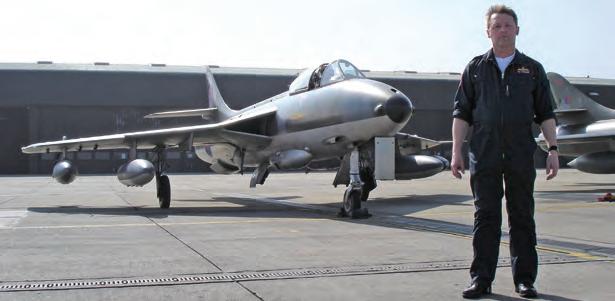
How many hours and types have you flown?
I think I’ve got about 9,000 hours on around 20 aircraft types, ranging from Airbus A340 down to a Thruster microlight. Thankfully over half of it has been proper flying (military and lighter aircraft), as thousands of long-haul hours sat in the cruise isn’t really flying.
Do you have a favourite and not so type?
The favourite is still the Sea Harrier, though my Auster is catching up fast! I don’t have any worst type as there’s always pleasure to be gained, even from an aircraft with poorer handling characteristics – the Challenger in a crosswind!
What aircraft have you owned?
The only aircraft I’ve ever owned, and in fact the only flying I’ve ever paid for myself, is an Auster 5D, G-ANHX. Built in late 1945, she missed WWII by a couple of weeks but did serve with the RAF and RAuxAF until the early 50s. She’s now painted as she would have been when serving with 661 Sqn RAuxAF – 661 Sqn Army Air Corps is now a Wildcat squadron based at Yeovilton. Small world!
What endears you to the Auster?
Possibly the only thing I don’t like is her manners in a crosswind, and the constant task of wiping oil off her from the ‘dripsy’ after every flight. I like the fact that her technology is comparable to my Willys Jeep – in fact I’m sure some parts are interchangeable. Any changes in the
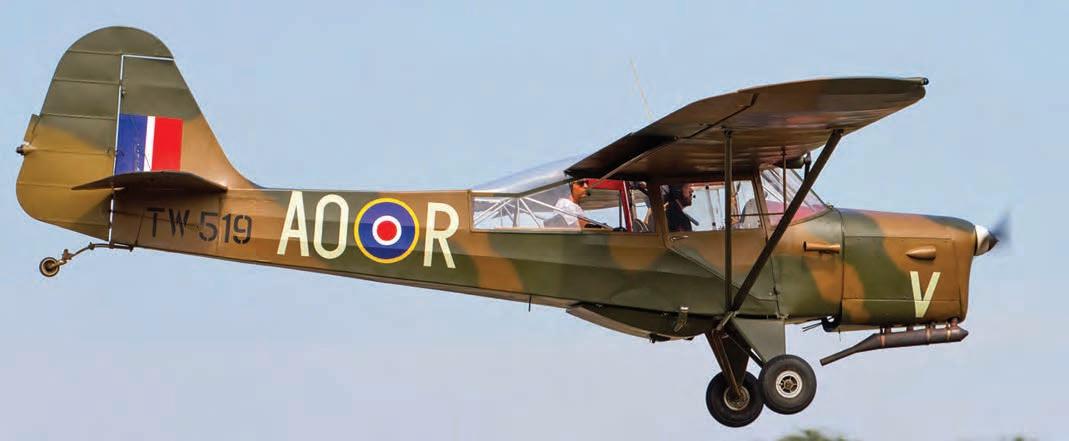
noises she makes – and there are many – are clues that something needs to be addressed. Hand swinging the prop is immensely satisfying, when she starts on the first, second or third blade; when we get to the 30th swing my enthusiasm is waning somewhat. It becomes a battle of wills!
Do you prefer local flying/fly-outs or touring?
As I’ve yet to do any touring (ignoring the day job) I’m not really qualified to discriminate, though at 90mph indicated, even a flight to Henstridge from Yeovilton is a tour of sorts.
Have you tried other aviation disciplines?
I’ve yet to try a balloon or a hang-glider, though in fact I’ve no desire for the latter. I consider myself a jet pilot only because that’s what I’ve spent most of my working life doing.
What has been your best aviation moment?
First solo in the Auster bringing her back to Yeovilton from Spanhoe. A beautiful August afternoon and on my daughter’s 21st birthday to boot. It was probably the first time I’d ever spent 90 minutes sightseeing...
My first deck landing in a Sea Harrier was memorable. Normally done close to land in case of problems, mine occurred mid-Atlantic and ended with a Head Up Display (HUD) failure. Normally this would have meant diverting to a land base as vertical landings without a HUD were never trained for. Not an option on this day... Most of the ship’s company came on deck to watch, expecting the worst!
Do you have any non-aviation hobbies?
Oldish cars, from my parents’ era, Mini Coopers, Ford Escorts, 2CVs etc. I fenced (epée not larch lap!) for a number of years and I am hoping to get back into that post-Covid lockdown. It’s great exercise for keeping old bodies supple, plus you can go to the pub after training.
Any aviation heroes?
Wing Commander Mick Martin – not the Mick Martin of Dambusters fame, although they did meet. This Mick Martin was my first squadron boss and an inspirational
leader, exceptional navigator and mentor. I still strive to lead like he did and I am proud that we’re still friends 30 years on.
Also, Chuck Yeager. As well as being an outstanding pilot and having ‘the right stuff’ in spades, he took the time to learn his aircraft technically. He claimed this gave him that ‘little bit extra’ which he used many, many times over his career.
Any good aviation books you’d recommend?
Fly West by Ivan Southall is a constant re-reader for me. Written for teenagers, it describes life as a Sunderland pilot during WWII. All the stories are fascinating, humane, and true. One of the book’s characters, Dudley Marrows, was recently featured in Aeroplane magazine. I’d have to include Biggles’ series of stories as well. Apart from being cracking yarns, they all contain valuable nuggets of aviation wisdom. Finally, Bomber and Goodbye Mickey Mouse by Len Deighton.
Any ‘I learned about flying’ moments?
During a test flight in a Sea Harrier the engine surged (stalled), then flamed out at 40,000ft. The SHAR wasn’t a great glider, but as all the manuals stated, the engine did relight below 20,000ft. It was a long five minutes though… know your aircraft, its systems and limitations.
I had the engine on a Hunter disintegrate and basically eat itself, but luckily we were on the runway at Boscombe Down.
If you’re going to have an engine failure, do it on the ground with two miles of runway ahead!
What’s on your aircraft or automotive wish list?
A P40 Kittyhawk with a shark’s mouth painted on it, a T-33 Shooting Star and a Ford Escort Mexico.
Any advice for fellow pilots?
Stay inquisitive – hear a new rattle from your aircraft? Hunt it down. A new regulation? Find it and read it. And always have a plan, even a loose one, and stick to it.
In aviation terms, ‘just’ should be replaced by ‘not’, as in ‘the runway will be just long enough’, ‘ we should just have enough fuel to make it’. ■


Summer’s here and it is, at last, time to have some fly-in fun, so please get out there and support the hard work that clubs, Struts and airfields do in organising events. There are still a few cancellations unfortunately, but hopefully things will be pretty well settled from now on.
Please do check events are on before heading out though, just in
June
4-6 Endelave (OY) Europa Nordic Fly-in
5 Fenland VAC Tulip Fly-in
5 Sandown Vintage Fly-in 01983-716926
5 Compton Abbas Vintage Saturday Fly-in
6 Duxford Flying Day [pre-book] sold out]
6 Old Warden S/worth Festival of Britain Drive-In Air Show [see AIC M012/2021]
12-13 Eshott 80th Anniversary of Sneum and Pederson’s escape from Denmark
17 Old Warden Shuttleworth Workshop Tour & Lunch
18-20 Gelnhausen (D) Fly-in & Air Show
19 Old Warden S/worth Chipmunk Drive-In Evening Show [see AIC M012/2021]
19-20 Taghmon (EI) ILAS Midsummer Fly-in
19-20 Turweston Air Britain Classic Fly-in [PPR] 01376-344441/ 01280-705400
19-20 Easter Midsummer Fly-in [PPR] 07967-715304
19-20 Hinderclay Meadows Suffolk Soaring Fly-in 07485-072155
19-20 St Michaels Wings & Wheels Microlight Fly-in
20 Duxford Flying Day (pre-book) [sold out]
20 Halfpenny Green Project Propeller
case local restrictions have been imposed which means it has had to be amended or cancelled at the last minute. This list comes courtesy of David Wise and the Royal Aero Club, see http://events.royalaeroclub. org/eventeu.htm for further details of these and other events in the UK and beyond. If you have an event you would like to add to the list, contact Dave at dave.wise@btinternet.com
WWII Aircrew Event
25-27 Headcorn Battle of Britain Air Show
26 Scarborough National Armed Forces Day Event
26-27 Breighton VAC Fly-in {PPR} 01757-288987
26-27 Haverfordwest RRRA Air Race
26-27 Sleap BAeA Aerobatics Introduction [see AIC Y008/2021]
26-27 La Ferte Alais (F) Salis Collection Air Show
27 Sandown Bader Braves Event 01983-716926
3 Middle Wallop Army Flying Museum Wings & Wheels Show
3 Duxford Flying Day
3 Compton Abbas Vintage Saturday Fly-in
3 Headcorn Armed Forces Day Event
3-4 Swansea Bay Welsh National Sea Front Air Show
3-4 Southport Sea Front Air Show
3-4 Headcorn Fire Show
4 Old Warden Shuttleworth Military Drive-In Air Show [see AIC M012/2021]
4 Henstridge LAA Wessex Strut Fly-in & Meet the LAA [PPR] 01963-364231
4 Priory Farm PFA Independence Day Fly-in & BBQ [PPR] 07799-695144
4-10 Deva (YR) FAI European Intermediate Aerobatic Ch’ships
5-8 Henstridge to Leicester LAA Tour of England (nightstops, BodminBarton - Breighton)
8-11 Goodwood Festival of Speed
9-11 Enstone BMAA SSDR Freedom Rally
10 Monewden LAA Suffolk Coast Strut Spirit of Monewden Fly in [PPR] 07391 858557
11 Headcorn Kent Garden of England Strut Fly-in
10 Burleigh House Battle Proms Concert
10-11 Sywell Flying Legends Air Show
10-11 Fenland (t.b.c.) BAeA Aerobatics Competition [see AIC Y008/2021]
1 Brimpton VAC Picnic [PPR - slots]
17 Old Warden S/worth LAA 75th Anniv Drive-In Evening Air Show [see AIC M012/2021]
17 Branscombe LAA Devon Strut Fly-in
17-18 Breighton Vintage Aerobatics Competition & Hangar Party [PPR]
17-18 North Coates Wings & Wheels Event 01472-388850
23-25 Brienne-le-Chateau (F) RSA Euro Fly-in
24 Brooklands Museum Vintage Aviation Festival
24 Firs Farm, Newbury Bring your own Sausages Fly-in & BBQ [PPR by air & road]
24-25 Leicester BAeA Aerobatics
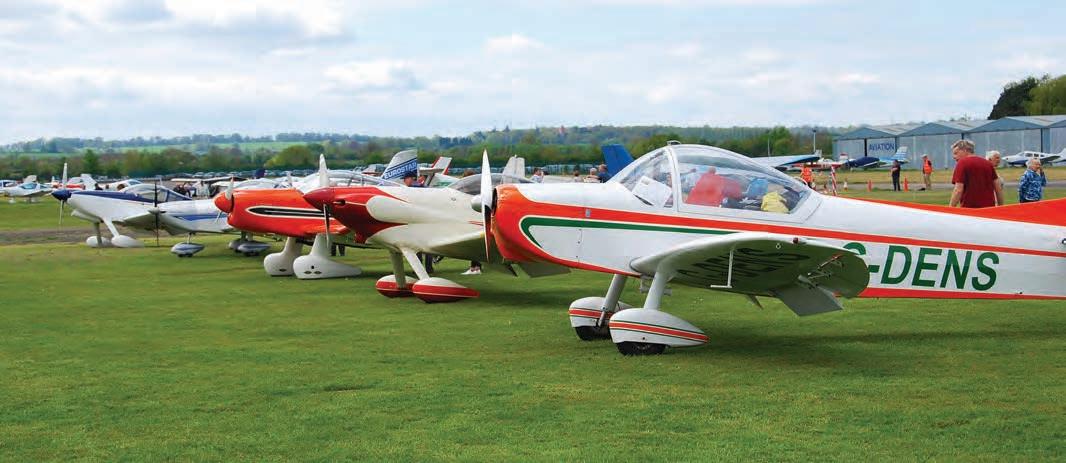

Competition [see AIC Y008/2021]
24-25 Duxford Air Festival (pre-book)
24-25 Sandown RRRA Air Race
24-25 Bodmin VAC Fly-in 01752-406660
24-25 Old Warden Shuttleworth Model Show – airfield closed
26-Au 1 Oshkosh, Wi (N) EAA AirVenture National Fly-in & Display
30-31 Compton Abbas BAeA Aerobatic Competition [see AIC Y008/2021]
30-Au 1 Old Buckenham Old Buck Air Show
31 Westonzoyland Scrumpy ‘n’ Cheese Fly-in [PPR]
31-Au 1 Rufforth East LAA Vale of York Strut Fly-in & Meet the LAA
AUGUST
1 Lundy Island Lundy Fly-in [PPR essential] 01752-406660/ 07805-805679
1 Old Warden Shuttleworth Air Show [see AIC M012/2021]
4 Duxford Flying Day
6 Church Fenton Private Flyer Exhibition
7 Compton Abbas Vintage Saturday Fly-in
7 East Kirkby LAHC Museum Air Show [advance booking]
7 Popham Classic Car Show & Anglo-French & Vintage Fly-in 01256397733
7-8 Blackpool Sea Front Air Show
7-8 Purleigh nr Maldon Echoes of History Mil Vehicles & Air Show
7-8 Headcorn Combined Ops Show
7-8 Sleap BAeA Aerobatics Competition [see AIC Y008/2021]
8 Popham Motorcycle Magameet & Anglo-French Fly-int 01256-397733
8-15 Hosin (OK) F AI World Microlight Ch’ships
11 Duxford Flying Day
14 Old Warden S/worth Flying Circus Drive-in Evening Air Show [see AIC M012/2021]
14-15 Popham Microlight Trade Fair 01256-397733
14-15 Sleap VAC Fly-in
19 Duxford Flying Day
19-21 Conington BAeA Aerobatics Spt & Int Nationals [see AIC Y008/2021]
21 Bodmin Bader Braves FOG Flying Day 01752-406660
21-22 Llanbedr RRRA Air Race
21-22 Halfpenny Green Wings & Wheels Event [PPR slots-pre book]
21-22 Popham Model Air Show [closed to full-size aircraft]
21-23 Whitby Regatta inc Air Show
26-27 Clacton Seafront Air Show
27-29 Alderney Alderney Fly-in [PPR]
27-29 Silverstone Motorcycle Races Moto Grand Prix
28 Henstridge Vintage Wings & Wheels 01963-364231
28-29 Rhyl Sea Front Air Show
28-29 Fenland (t.b.c.) BAeA Aerobatics Competition [see AIC Y008/2021]
28-30 Glenforsa, Mull Vans RV Fly-in [PPR] 01680-300377
29 Little GransdenbAir & Car29 Little Gransden Air & Car Show
29 Breighton Chilton & Micron Engine Fly-in
2-5 Bournemouth Sea Front Air Show
3-5 Sywell LAA National Rally & Exhibition [PPR-slots] 01280-846786
3-5 Chatsworth Country Fair inc Airshow
3-5 Foxlands Farm, Cosby Victory Show
4 Compton Abbas Vintage Saturday
Fly-in
4-5 Old Warden S/worth Vintage Weekend & Sunday Air Show [see AIC M012/2021]
4-5 Popham STOL Competition 01256-397733
4-5 North Coates Summer Fly-in 01472-388850
9 Guernsey Guernsey Air Show
9 Jersey Jersey Air Show
10 Abingdon Threshold Pre-Airshow Dusk Photo-shoot [Pre-book]
11 Bodmin LAA Cornwall Strut Fly-in 01752-406660
11 Abingdon Air & Country Show [pre book]
11-12 Cosford RAF Air Show (t.b.c.)
11-12 Church Fenton RRRA Air Race
11-12 Glenforsa, Mull Vintage Tailwheel Fly-in [PPR] 01680-300377
12 K2 Centre, Crawley Gatwick Air Enthusiasts Fair 01403-252628
17-18 Wycombe - Booker The Elite Lifestyle & Private Flyer Exhibition
17-19 Goodwood Revival Meeting
18-19 Headcorn LAA Kent Strut Fly-in and Meet the LAA Day[PPR]
18 Sutton Meadows Cambs MC Microlight Fly-in
18-19 Duxford Battle of Britain Air Show (pre-book)
18-19 Sywell Classic Pistons & Props Show
18-19 Rougham NW Marshalling Team Vintage Fly-in [PPR] 07592-018984
18-19 Old Warden Shuttleworth Model Show – airfield closed [see AIC M012/2021]
23 Old Warden Shuttleworth Workshop Tour & Lunch
25-26 Leicester RRRA Air Race – Kings Cup
25-26 Breighton BAeA Aerobatics Competition [see AIC Y008/2021]

By
Ihope you’ll enjoy the added bonus this month of your copy, free of charge to all members, of a special LAA book. As we come out of Covid lockdown, I hope this marks a great way to kick off the celebrations of our 75th Anniversary. The book takes us back to 1946, when the Ultra Light Aircraft Association was inaugurated.
Looking back, it is amazing how the same challenges have come up time after time over the succeeding decades – airspace threats, airfield closures, economic upheavals and well-meaning but sometimes overzealous legislators.
Speaking of which… Thank you to all who have responded to the CAA’s public consultation on the proposed changes to delegated airworthiness organisation approvals. At the time of writing, I’m informed that the CAA ‘inbox’ contains several hundred responses, an unprecedented level for such a consultation.
As I wrote in an email to members, the LAA has serious reservations about many of the changes proposed, including the introduction of large swathes of regulation from the certified world which significantly increase bureaucracy and the cost of providing an airworthiness service, with no commensurate improvement in the safety of our activities. If these changes are passed, the costs of the additional administration and bureaucracy will inevitably have to be passed on through higher fees to LAA members.
In addition to the proposals themselves, we have expressed serious disquiet about how they were achieved. In the past, all major changes to regulations have been achieved through a collaborative process that have almost always produced a result that is supported and respected by those who have to implement those regulations. The original A8-26 approval was created via a working group consisting of the CAA, the LAA and the BMAA, involving nearly three years of collaborative effort to achieve the agreed regulation. This time, despite our asking to be involved, there has been no such attempt at collaboration.
At the end of 2019, we discovered that the CAA General Aviation Unit (GAU) had been working on a revision to A8-26, using resources from outside of the GAU (rather than those familiar with LAA and BMAA procedures) to develop changes, and without the usual collaborative working group process.
Although some minor changes have been made as a result of subsequent representations, it is regretted that the CAA has decided to put these proposed changes out for public consultation without having achieved a consensus, which means that our differences have to be aired in public.
The consultation closed on 28 May and it will be interesting to see how the CAA will respond to our proposal that the CAA should temporarily withdraw these proposals, and only resubmit
them after a collaborative working group has been convened and a proper consensus with both BMAA and LAA achieved. I genuinely hope that we can return to that type of relationship. Perhaps like us, the CAA can learn from history and build for the future.
Another thing that the LAA 75 book research taught me is that even the Covid lockdown, or at least its effect on recreational flying, had its historical precedent. Twenty years ago this year, we had to abandon plans for the Popular Flying Association’s annual Rally, at that time due to restrictions on flying posed by an outbreak of Foot and Mouth disease.
Last year of course, the LAA Rally was a casualty of the pandemic. This year we hope it will be different. Our plans for the 2021 Rally at Sywell from 3-5 September include a redesign of the exhibitor area to allow social distancing to be maintained, with more open-sided marquees to ensure appropriate ventilation. Other attractions, such as our ‘Speakers Corner’ and evening entertainment, are also being developed to offer Covid-safe environments. The Rally will also celebrate the 75th Anniversary with special exhibits and some rarely seen aircraft of all generations.
Most importantly, as our Rally Chairman Eryl Smith has said, “It’s not just a commemoration of 75 years of the largest powered flying Association in the UK, but also a celebration of the return to a normal, stress and Covid risk-free way of life.”
Of course, the LAA Rally and the book are not our only celebrations. As you’ll read in these pages (if like me, you start with the adverts and work forwards), you’ll see updates on our LAA 75 Anniversary Tour and also our ‘Flying For Fun’ evening airshow and gathering at the Shuttleworth Collection. All are welcome, so I hope we can get together in July and enjoy our passion for flying.
From the beginning the ULAA, PFA and latterly the LAA’s aims have been ‘affordable aviation’ and most importantly, ‘flying for fun’. Today our priorities remain the same, enhanced by new technologies. The new generation of factory-built, 450-600kg light sport aircraft will offer sport flyers even more choice and I’m glad to report that after a short hiatus while CAA and DfT lawyers discussed legal definitions for the new legislation, the CAA hopes to announce the new category just before the LAA Rally.
We hope to see some of the first of the new types at Sywell, and as the LAA is also the perfect environment for innovators to drive forward with alternative technologies that will see the next generation of sport flyers taking to the air, we might see some other new ideas too. Exciting times indeed! ■
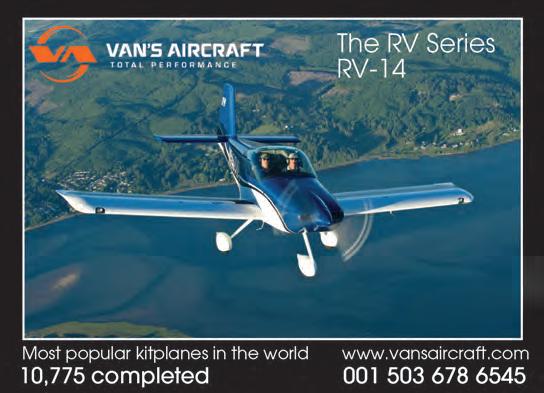






For all display or commercial advertising enquiries please contact Neil Wilson: 07512 773532 neil.wilson@laa.uk.com
You can email your classified advertisement direct to the LAA at the following address: office@laa.uk.com
Deadline for booking and copy: 21 June 2021
If you would like to place an aircraft for sale advert please see details below:
MEMBERS’ ADVERTISEMENTS
Up to 30 words: £6; 31-50 words: £12
Up to 50 words with a coloured photo: £45
NON-MEMBERS’ADVERTISEMENTS
Up to 30 words: £22; 31-50 words: £44
Up to 50 words with a coloured photo: £60 www.laa.uk.com
LAA Engineering advice to buyers:
AIRCRAFT APPROVED? Members and readers should note that the inclusion of all advertisements in the commercial or classified sections of this magazine does not necessarily mean that the product or service is approved by the LAA. In particular, aircraft types, or examples of types advertised, may not, for a variety of reasons, be of a type or standard that is eligible for the issue of a LAA Permit to Fly. You should not assume that an aircraft type not currently on the LAA accepted type list will eventually be accepted.
IMPORTED AIRCRAFT? Due to unfavourable experiences, the purchase and import of completed homebuilt aircraft from abroad is especially discouraged.
TIME TO BUILD? When evaluating kits/designs, it should borne in mind that technical details, performance figures and handling characteristics are often quoted for a factory-produced aircraft flying under ideal conditions. It is wise, therefore, to seek the opinion of existing builders and owners of the type. You should also take your own skill and circumstances into consideration when calculating build times. The manufacturer’s build time should be taken as a guide only.
AMATEUR BUILDING
All LAA aircraft builders and potential builders are reminded that in order to qualify for a LAA Permit to Fly, homebuilt aircraft must be genuinely amateur built. For these purposes the CAA provide a definition of amateur built in their publication CAP 659, available from LAA. An extract from CAP 659 reads “The building and operation of the aircraft will be solely for the education and recreation of the amateur builder. This means that he would not be permitted to commission someone else to build his aircraft”. An aircraft built outside the CAA’s definition could result in an expensive garden ornament.
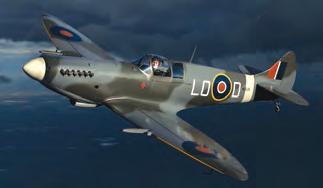
Spitfire Mk26 G-CJWW. 30hrs TTAE. Factory new Jabiru 5100 with Rotec liquid cooled head and alternator conversion. Sensenich FP propeller. Permit April 2022. One of the finest examples available and winner of best kit/ replica at the 2019 LAA rally. Contact for link to photos/videos. £125k. Martin 07773 577675.
Rans aircraft 116 Coyote Group A . Always hangered with trailer. Needs some work doing for Permit. Lots of extras included. £4,500 Offers invited. Please contact 07892 376986 for details
Wanted - Sequoia Falco parts from either a stalled project or spare. Interested in any parts but particularly wing Ribs, u/c components, canopy components, IO-360 cowlings, fairings, gear doors, trim and upholstery. iaviate@icloud.com
Magnetos and Harness. Bendix Scintilla SF4RN-8 spec 10-19293-2, with gears, R/H rotation. Off A65. Hours unknown. Became hard to start when warm. IMHO requires o/haul. Serviceable Skytronics harness. £200 or offers. peter.pdyer@gmail.com 07791 550012
Rotax 912UL 80 H.P. Engine boxed, new with firewall forward parts included. £12,500. Offers invited Please contact 0789 237 6986 for details. Overhauled Fairey Reed suitable for certain Auster, Chrislea Super Ace etc. Was bought from Peter H and came with paperwork, having been overhauled. Paperwork was lost whilst in France. Propeller has never been unwrapped. Has yellow tips. Condition is “Overhauled”. DWG No A666 971/X7. PR 42269 CIRRUS MAJOR. £3,325.00. I can deliver within 50 miles of SP5 1LJ. Tel: 01794 341184
Hangarage / outside parking available private strip near Huntingdon / Peterborough. 700M grass runway. On site security. Tea/coffee facilities. Toilets. Great place to operate. Email: aerium2020@outlook.com Tel 07808 808945
Design & Stress Analysis Service. Type submissions, modifications, engine frames and general advice. We cover everything from SSDR to A380 :- structures, powerplant (IC and electric) and avionic installations. Contact John Wighton enquires@acroflight.co.uk or call 07770399315. SERVICES

Whetheryou are: -Purchasing an aircraft -Carrying outupgrades -Inneed of maintenance
FindouthowA rkle could help to financethecost so youcan take to theskies oncemore.
Callnowfordetailsanda no -obligation quotation

A WHIRLWIND AFFAIR - WITH AVIATION by Ron Webster
The story of a lifetime affair with aeroplanes and engines. Ron designed and built three Whirlwind radial engines, air-testing them with FRED G-BMOO. A rattling good read. £10.00 plus £2.00 postage and packing. Order from maryh.webster@tiscali.co.uk or Tel: 01162 393706.
France, Loire, hangarage for two aircraft at our private airfield “ Montrichard”, four-person cottage, package designed by flyers for flyers. £800 per week, www.lachaumine.co.uk, 07802 217 855, 01424 883 474.


